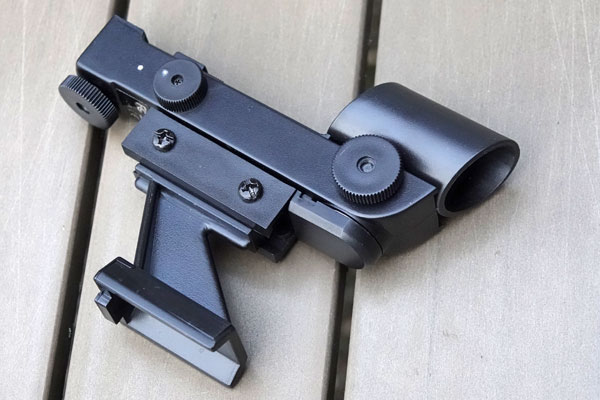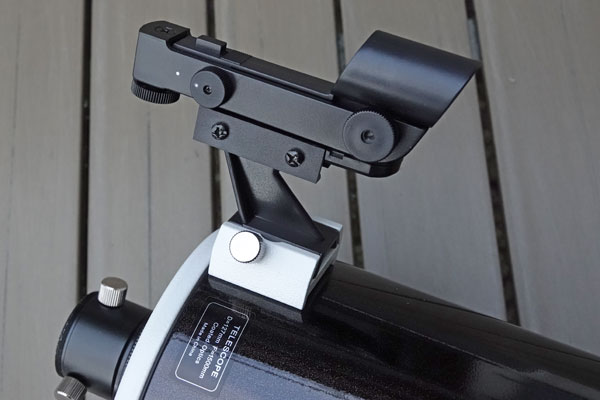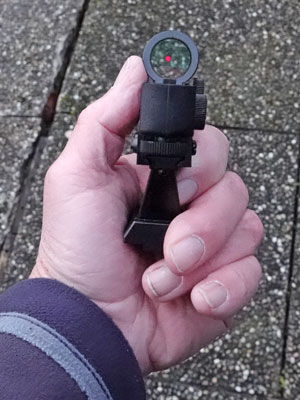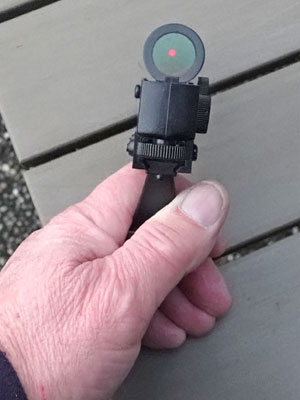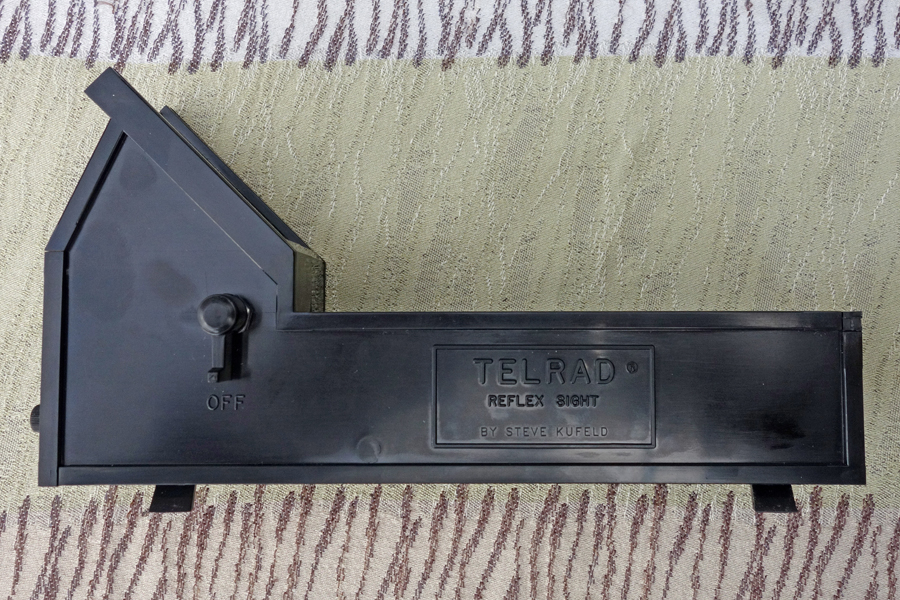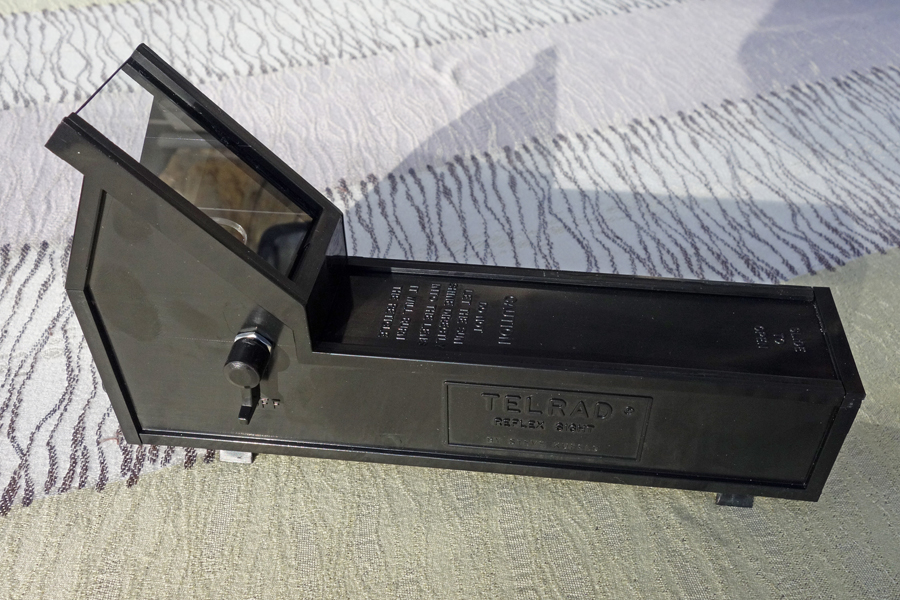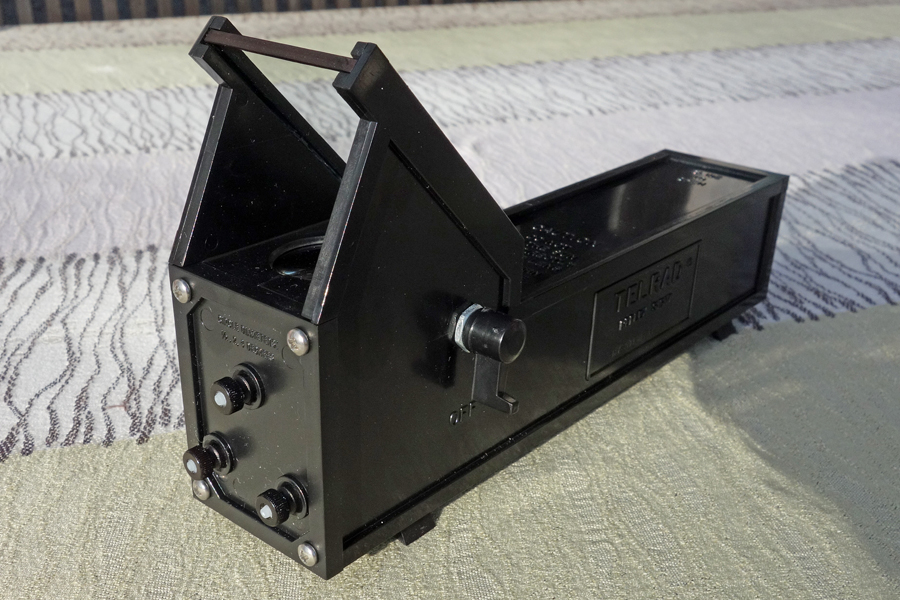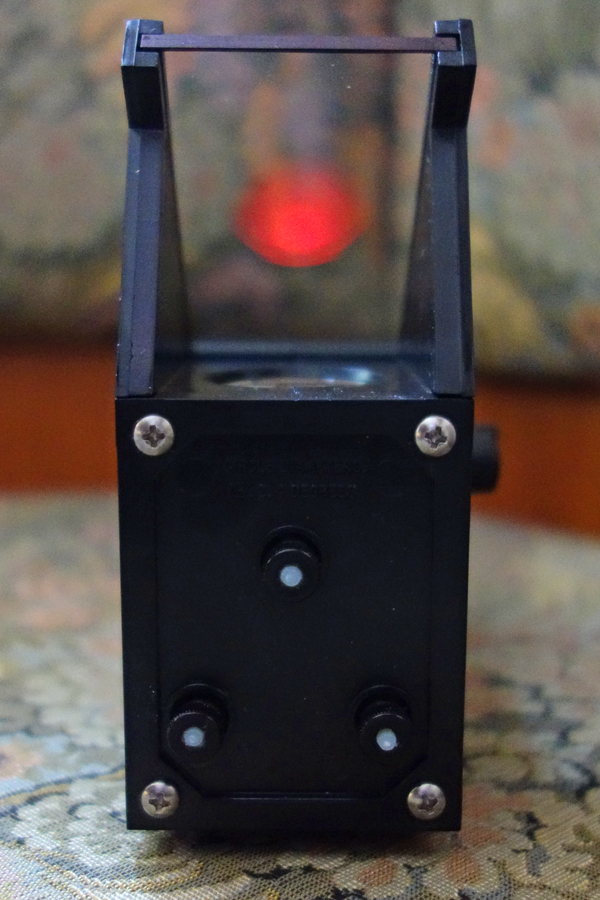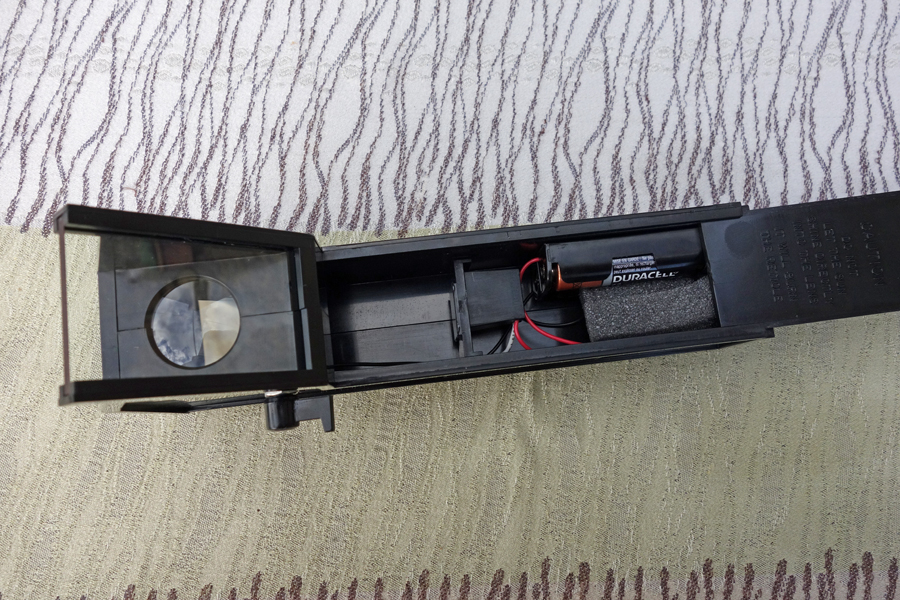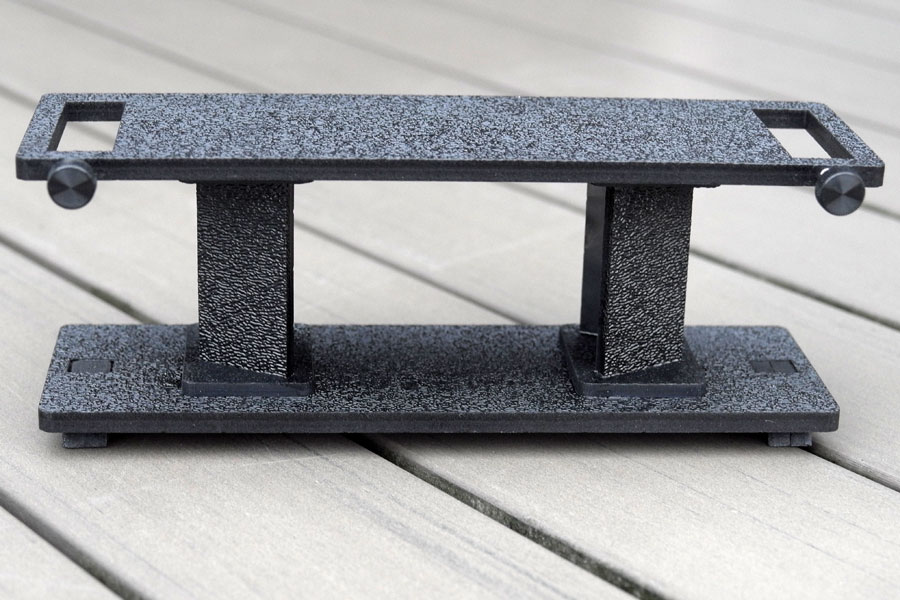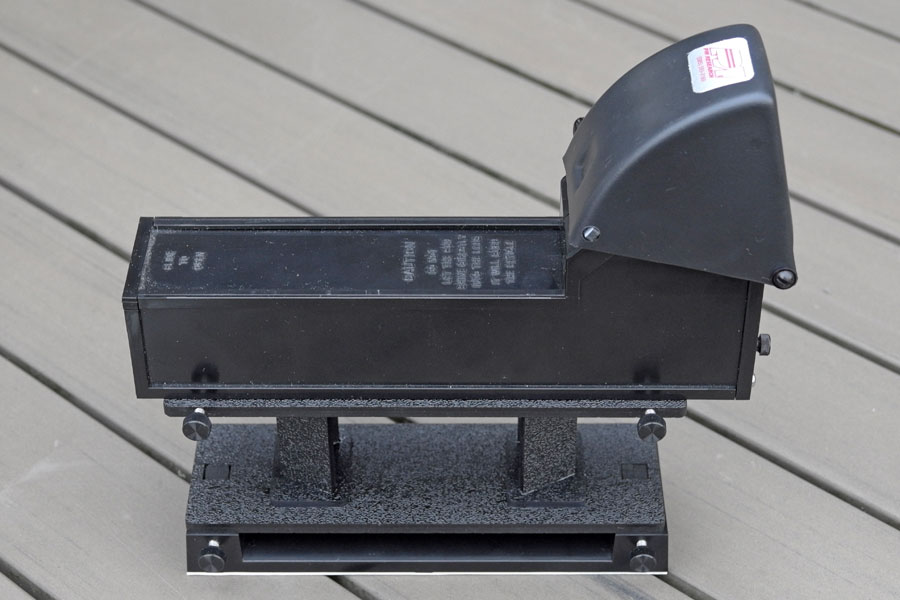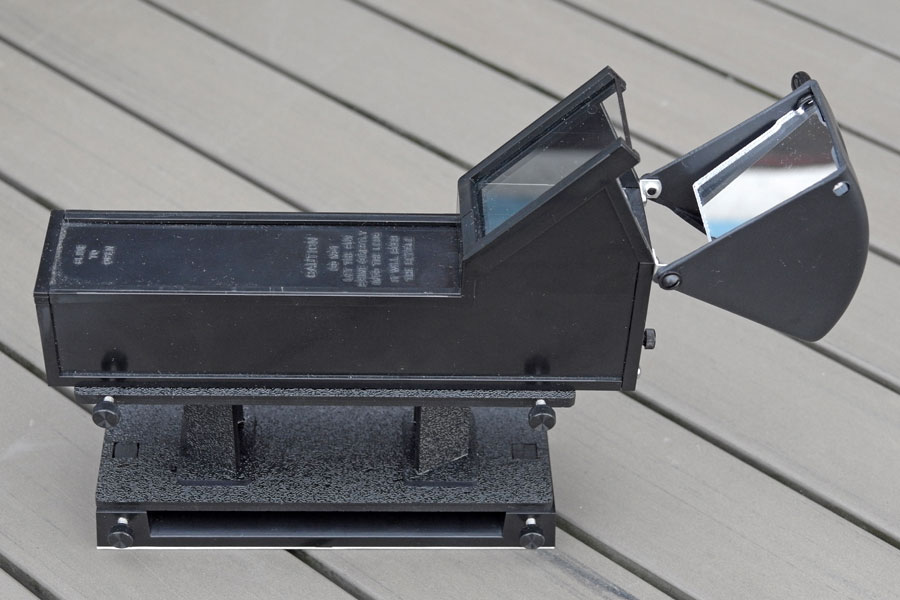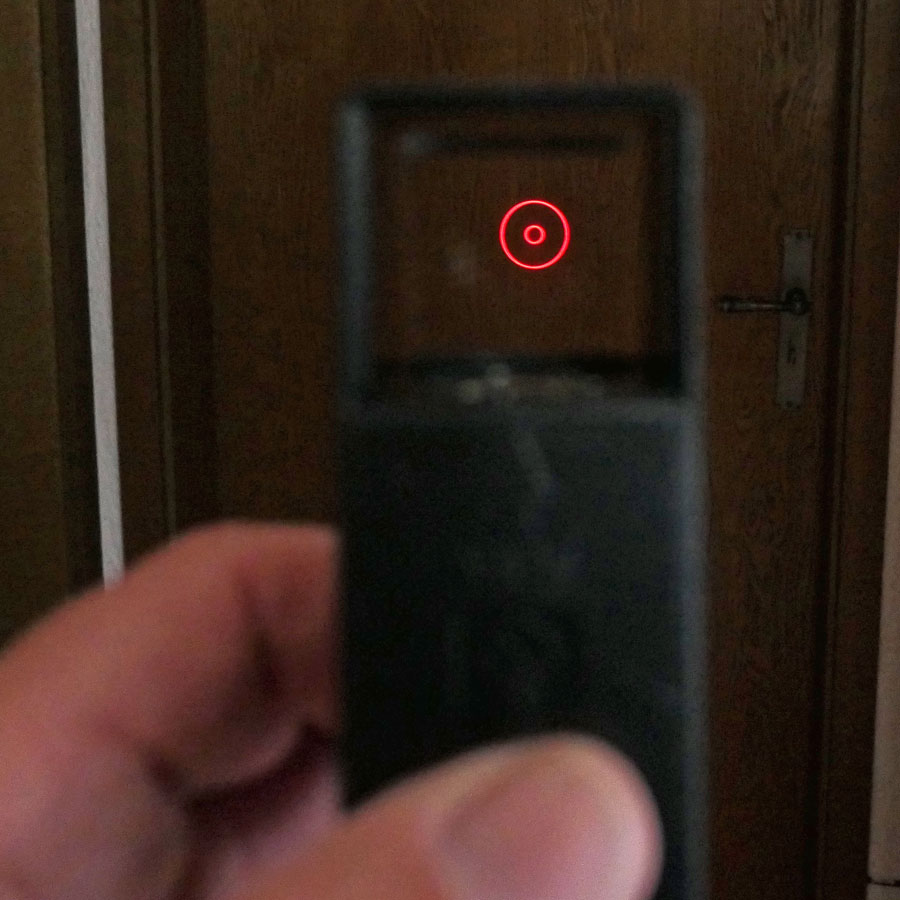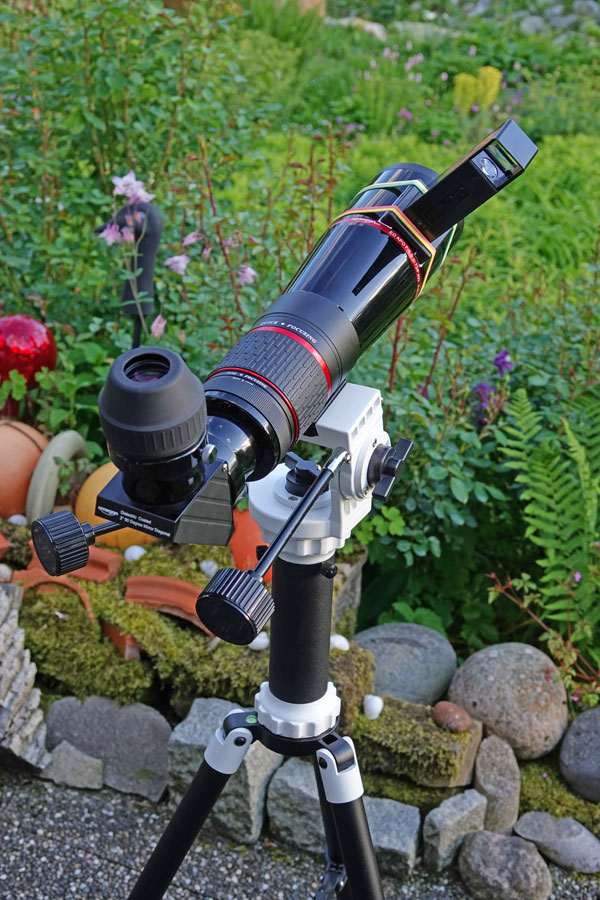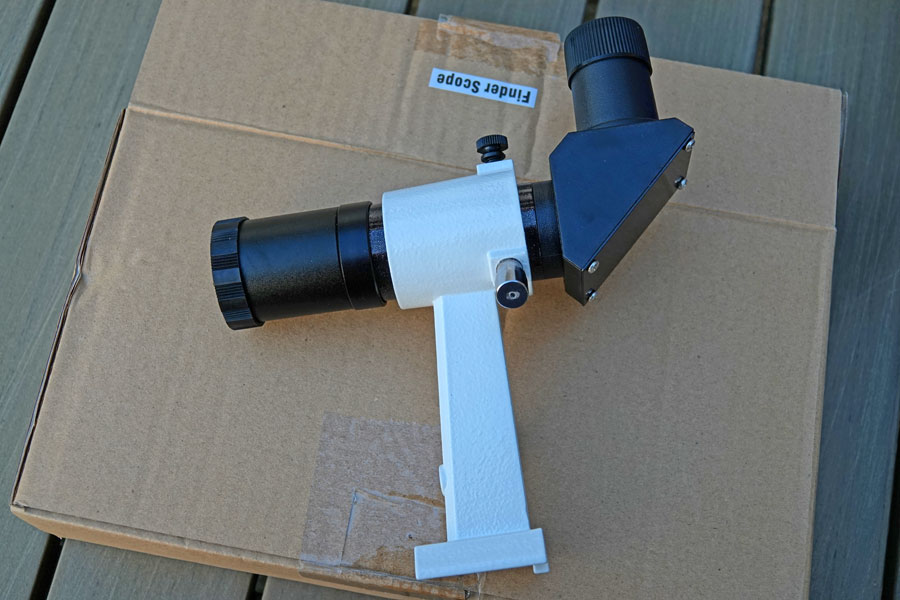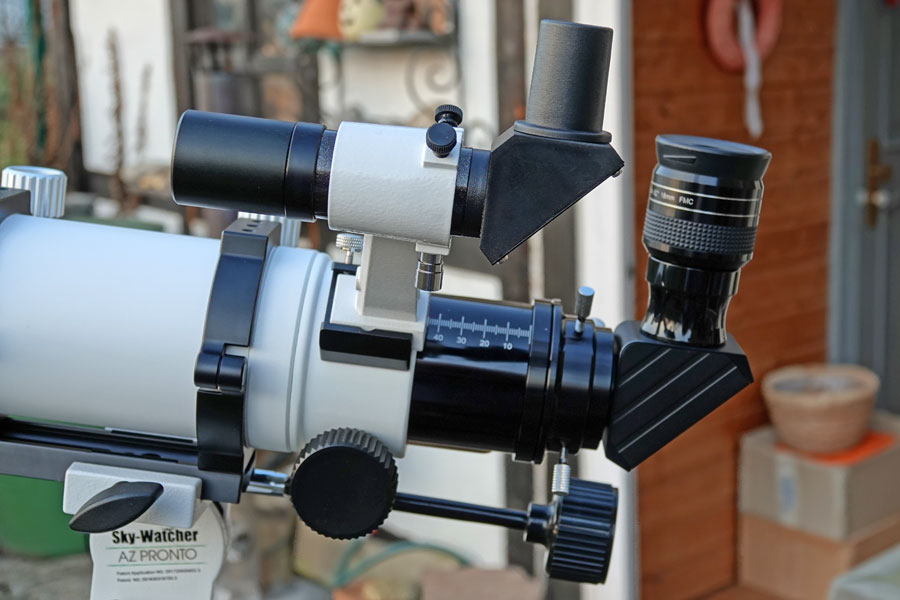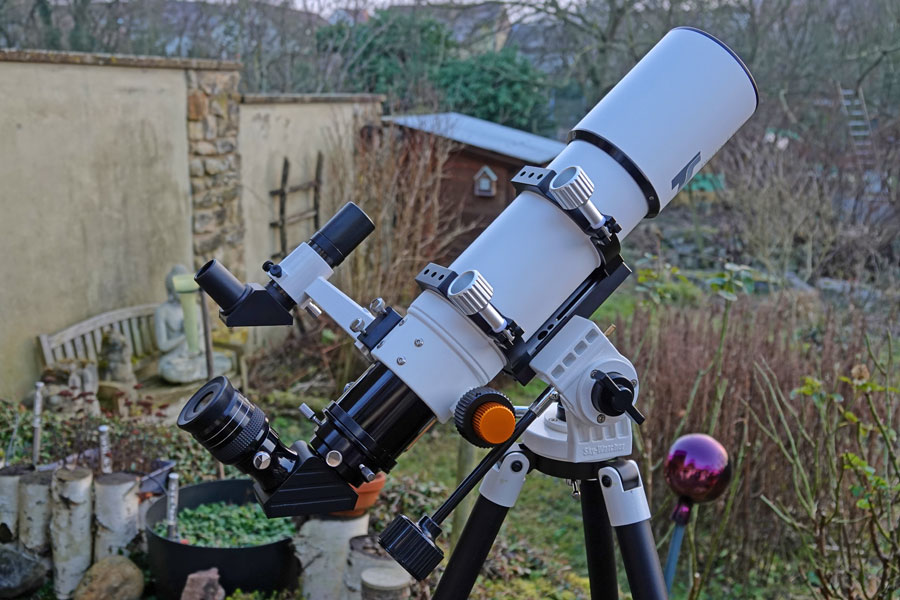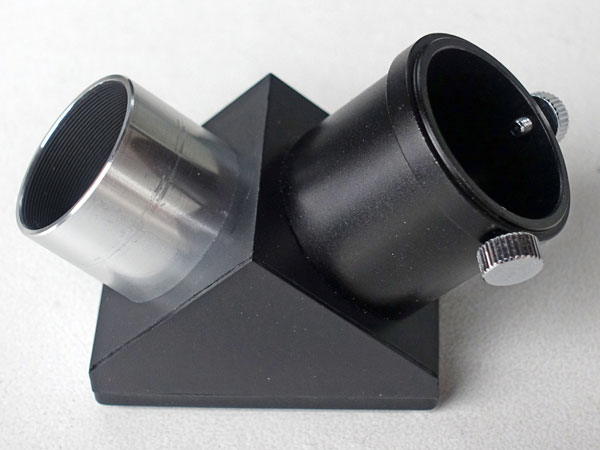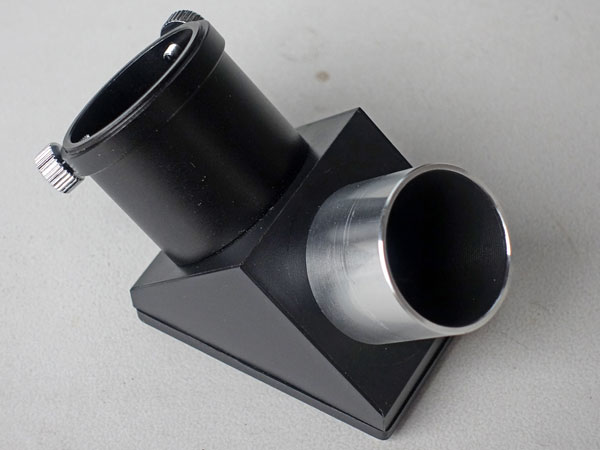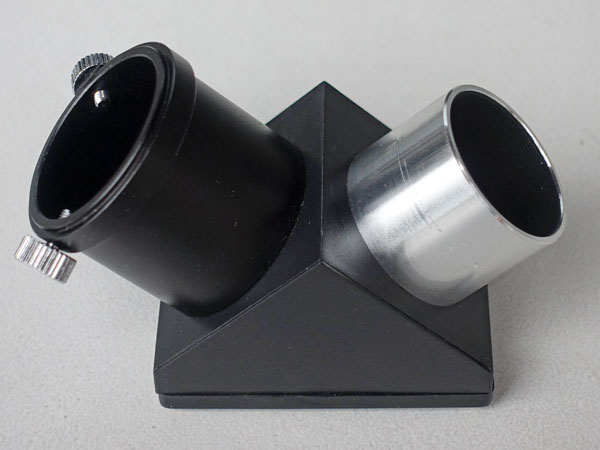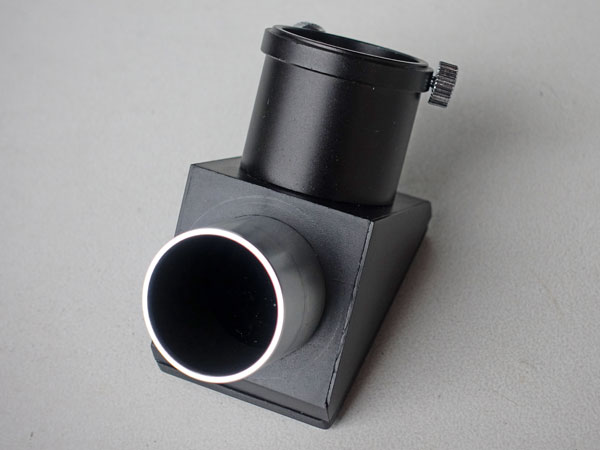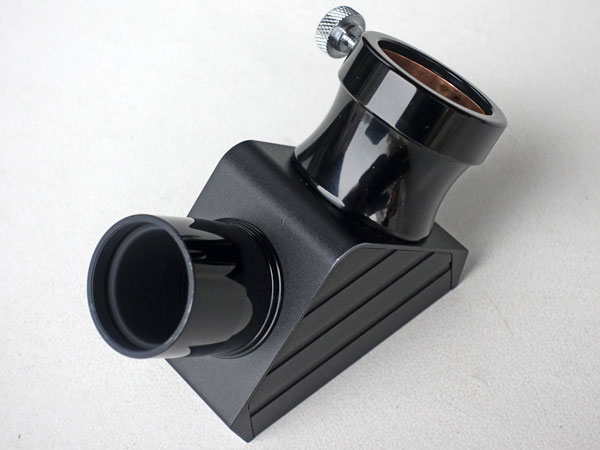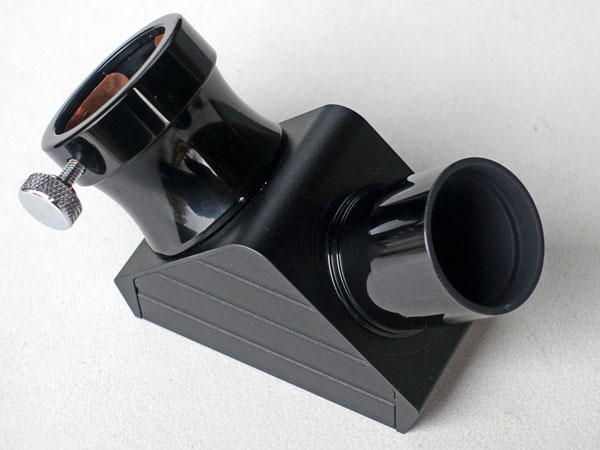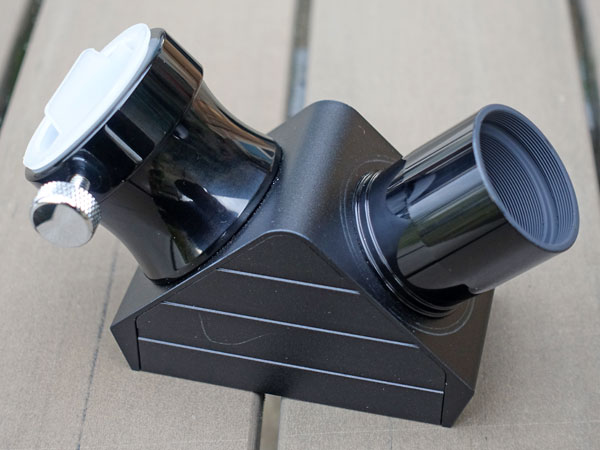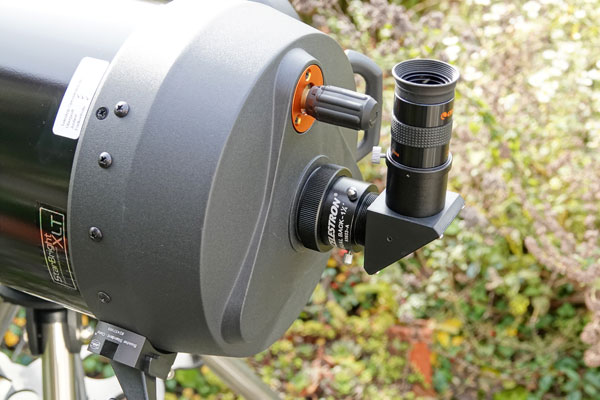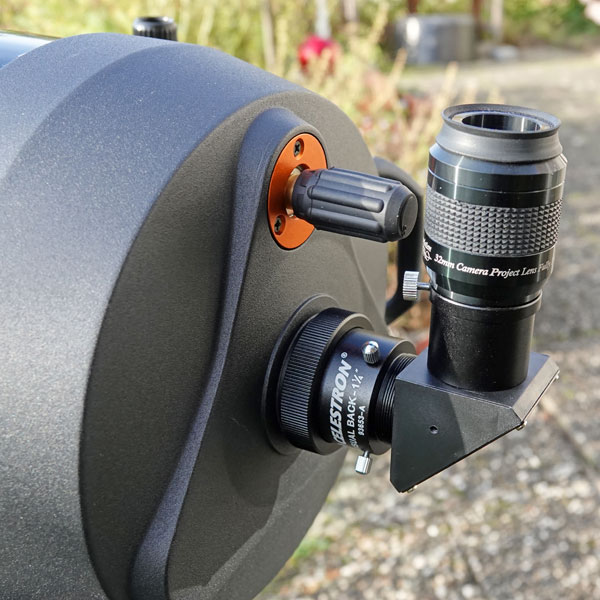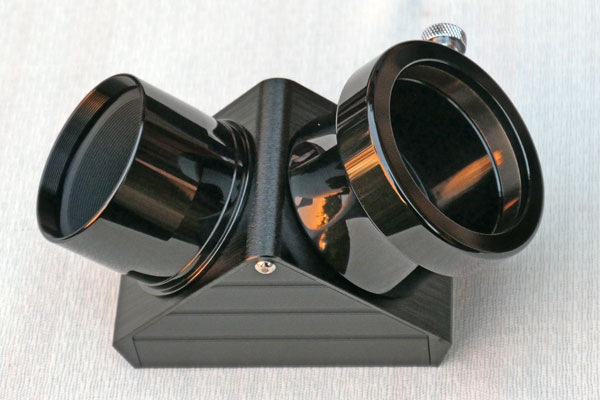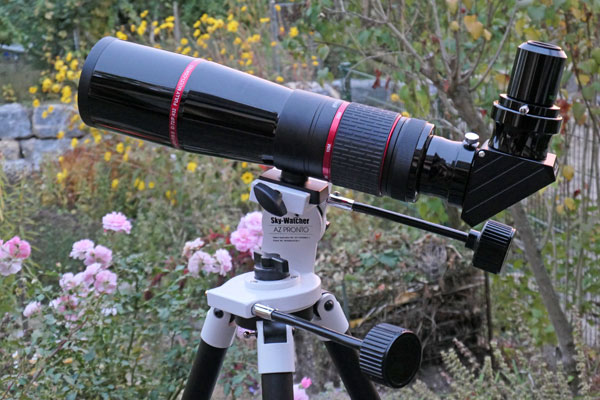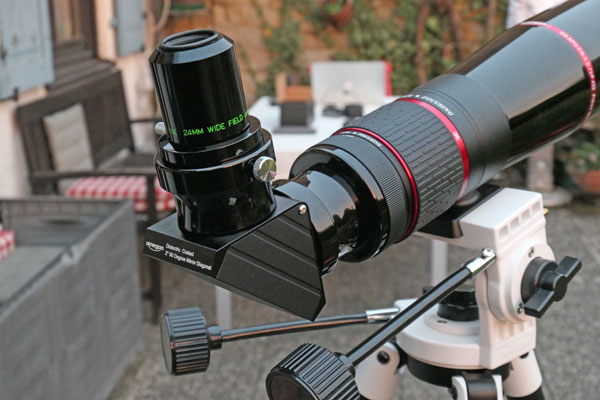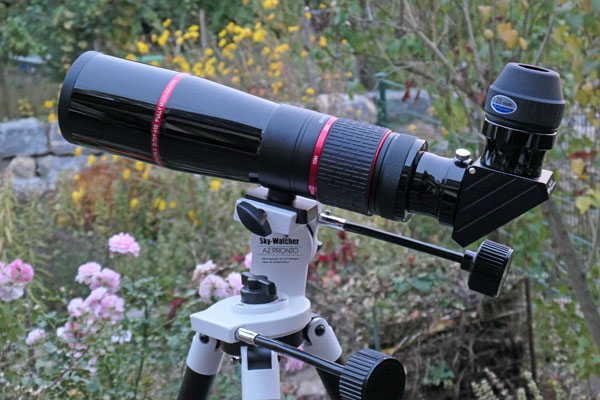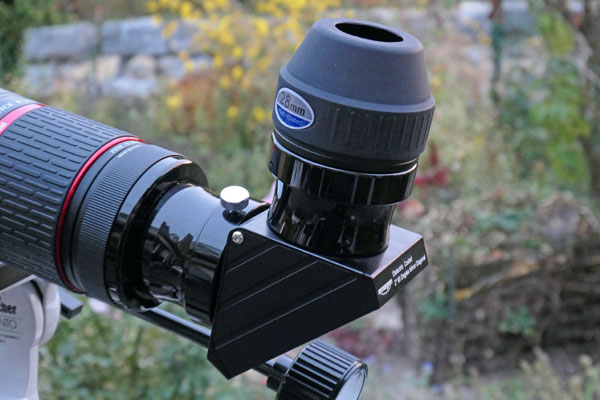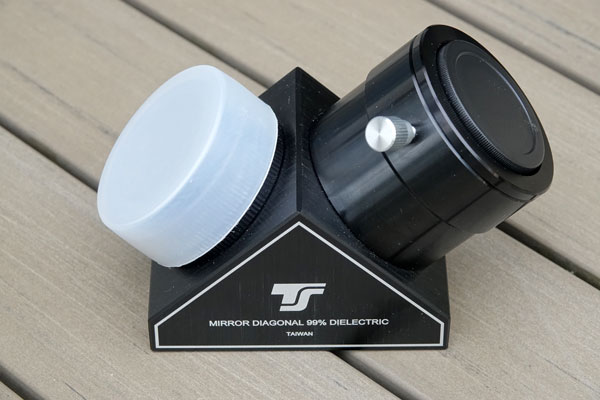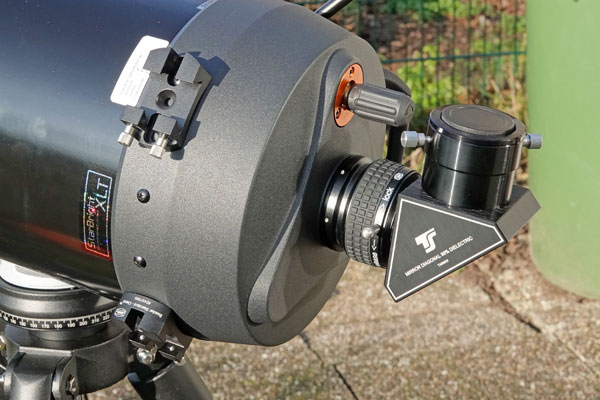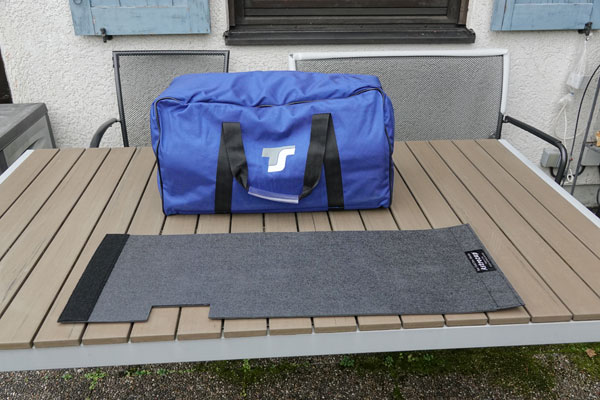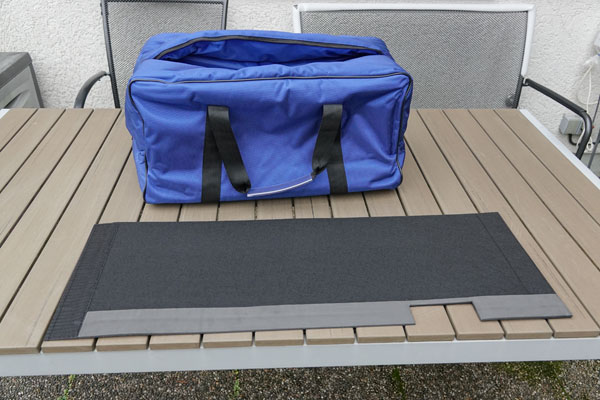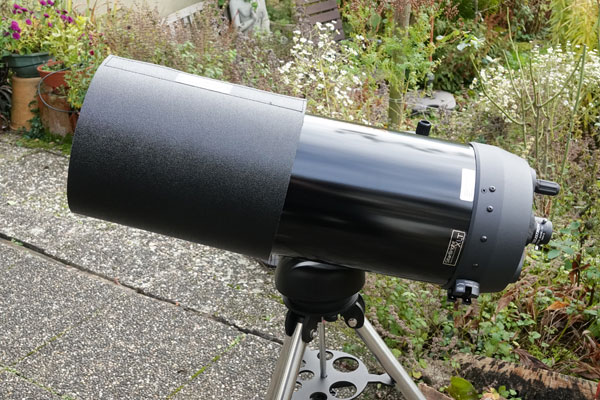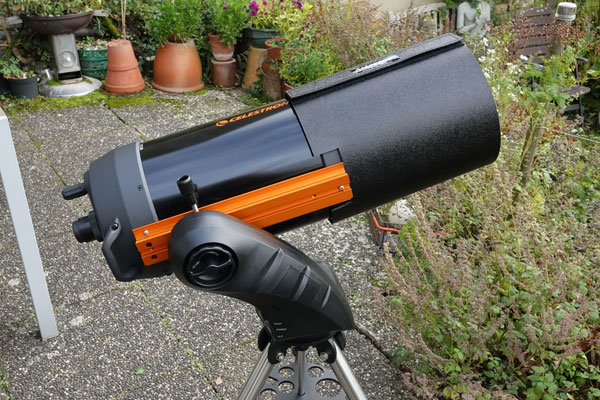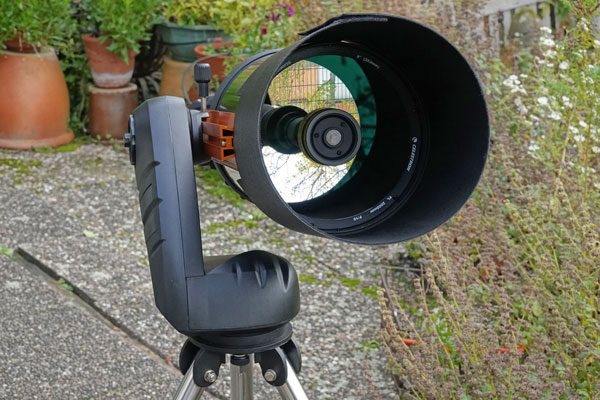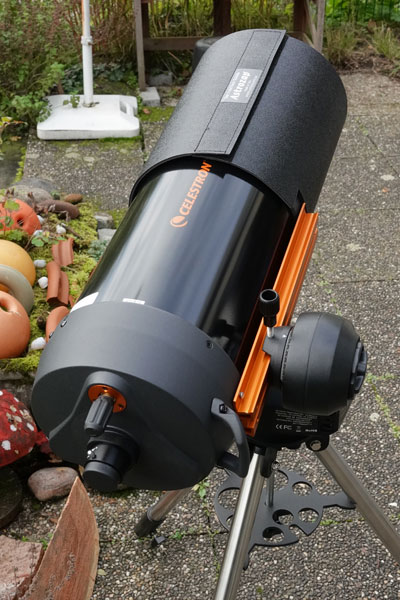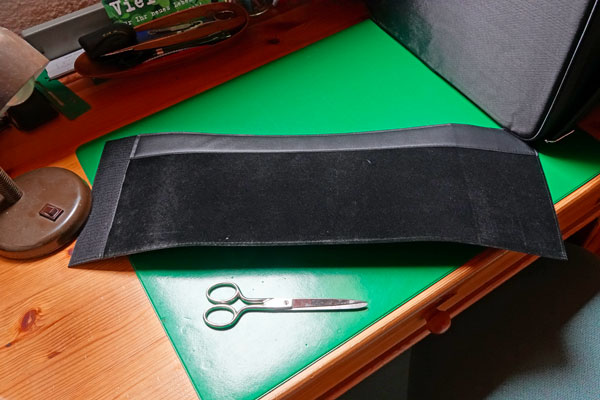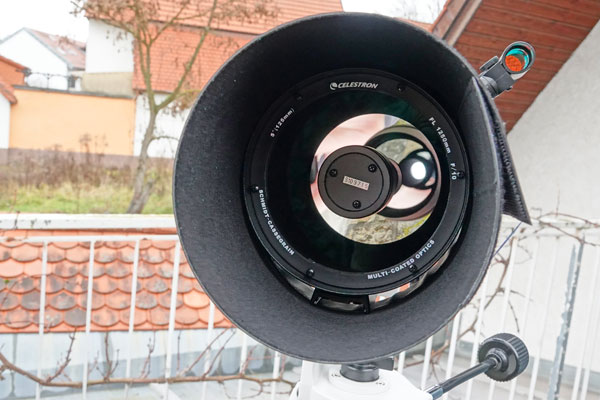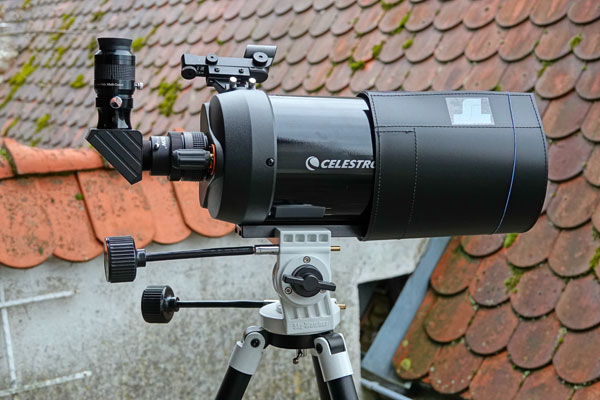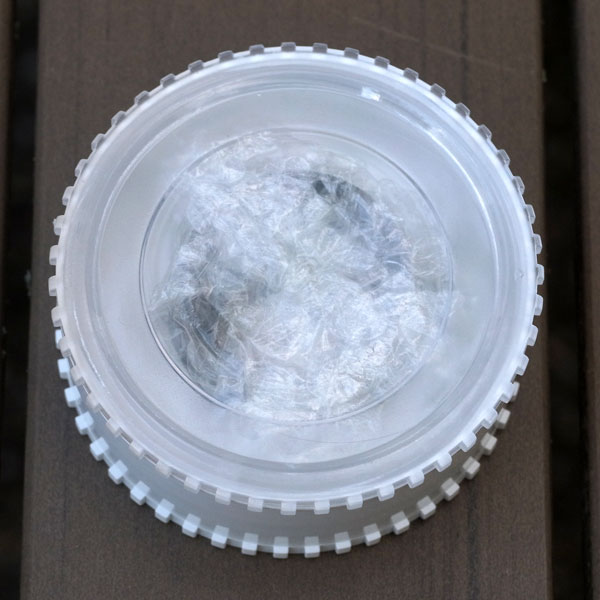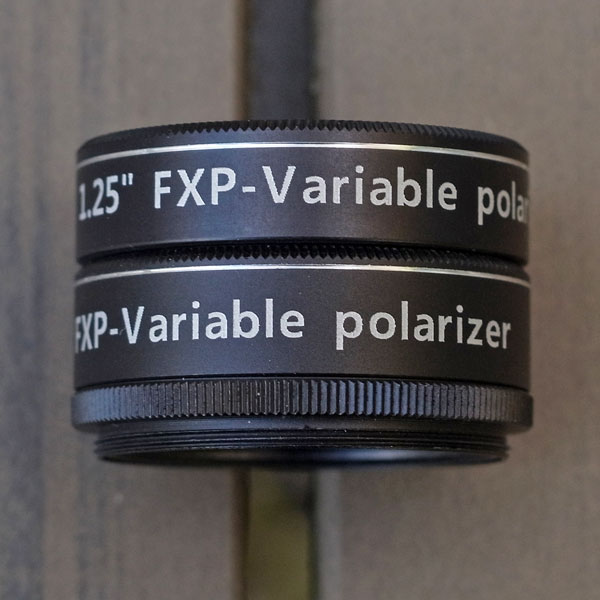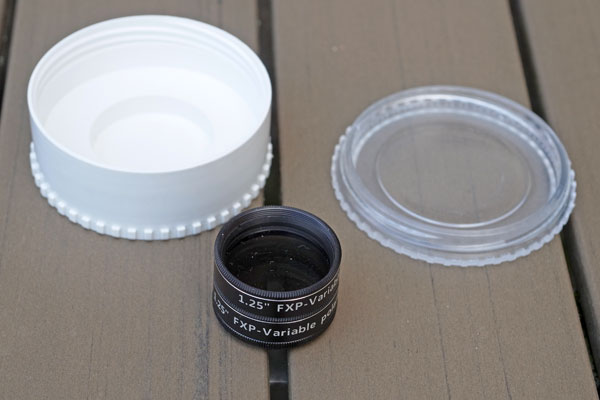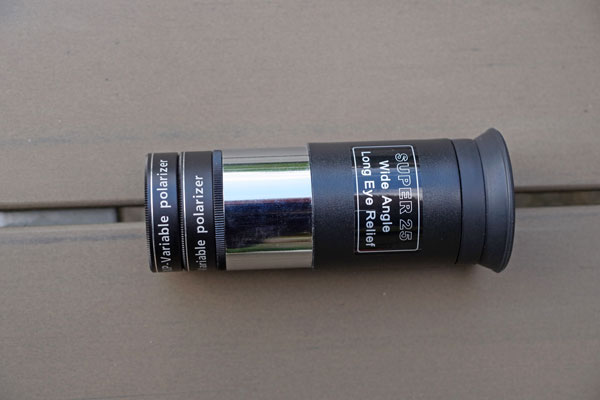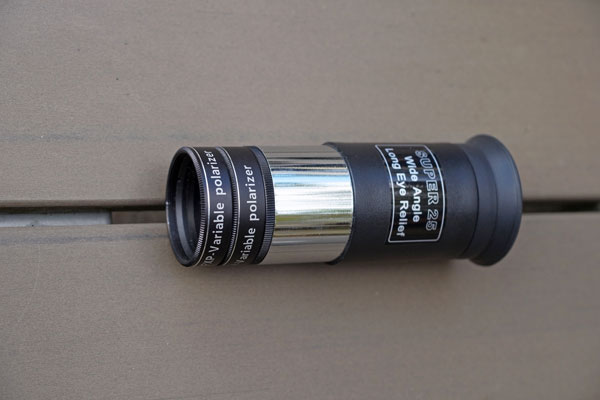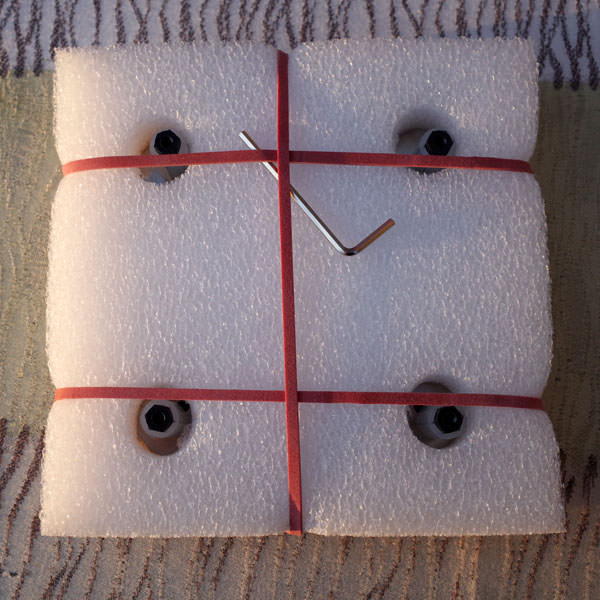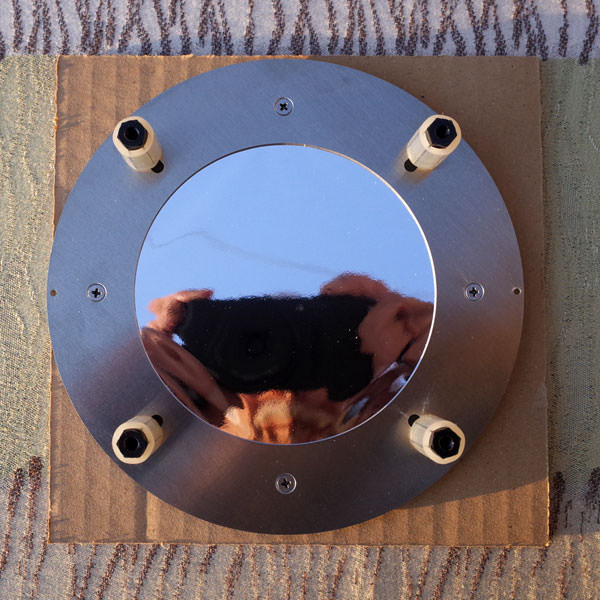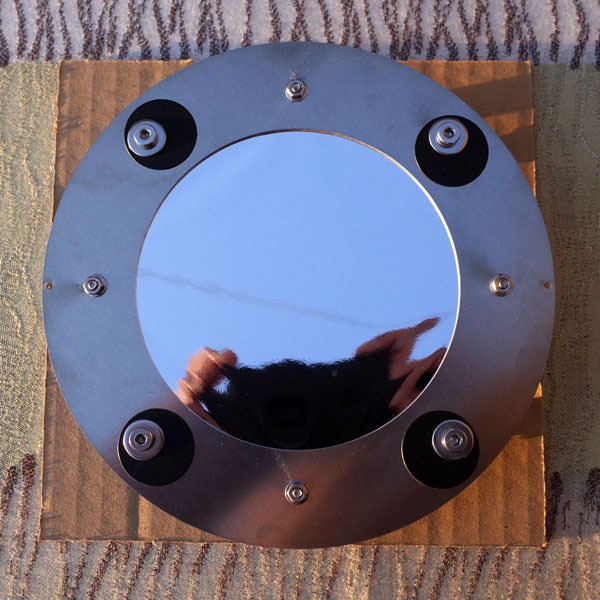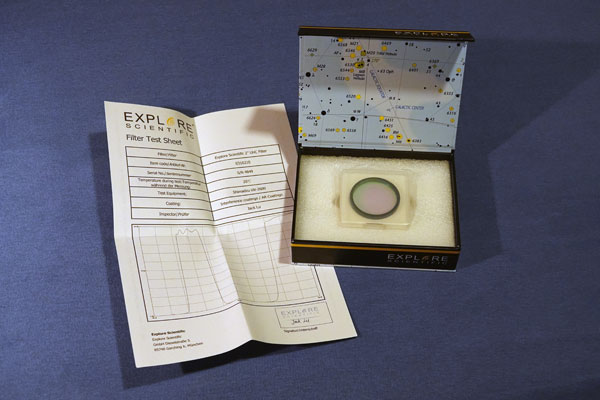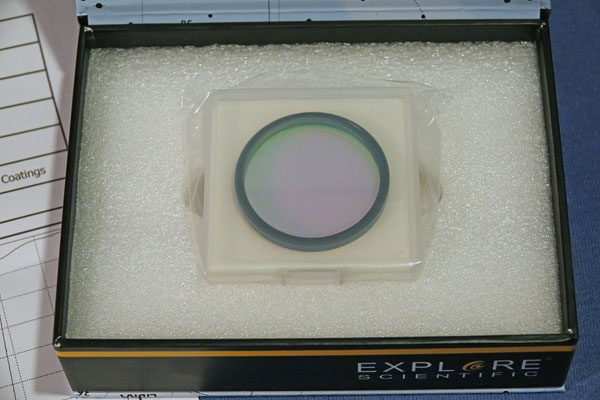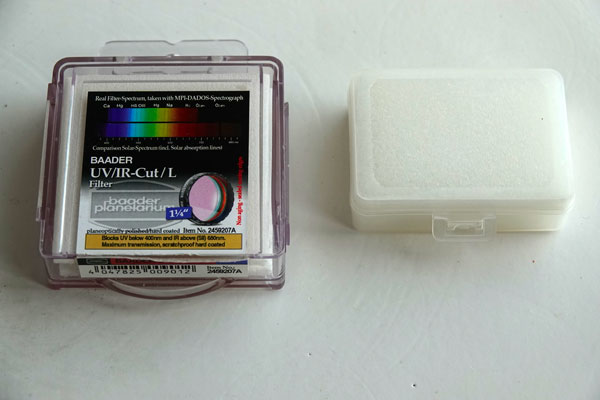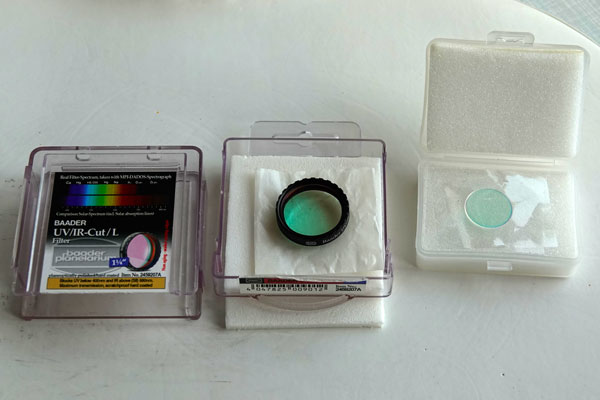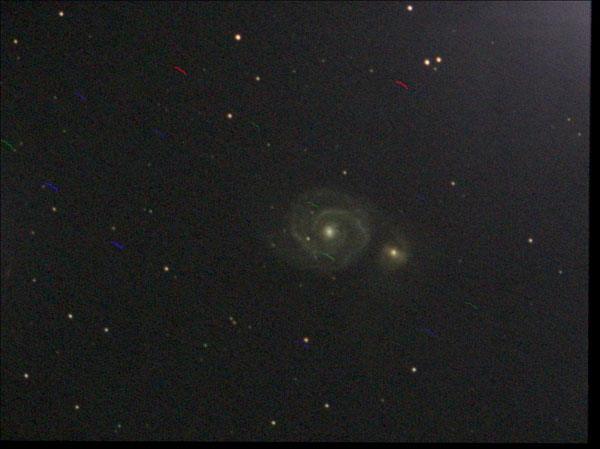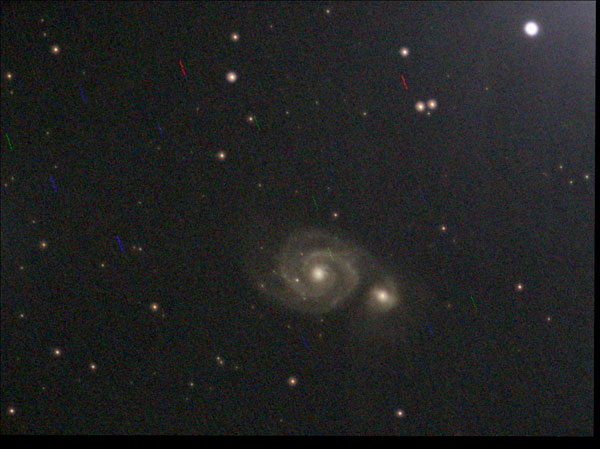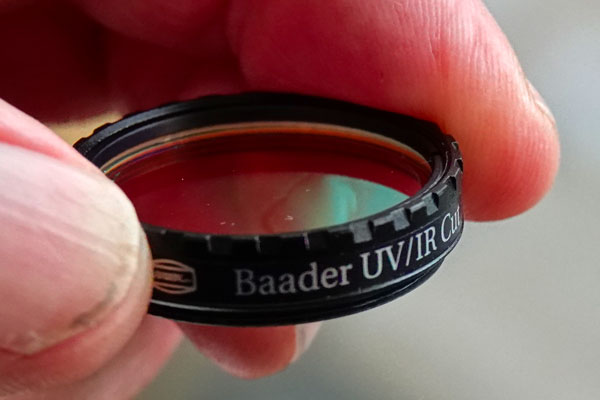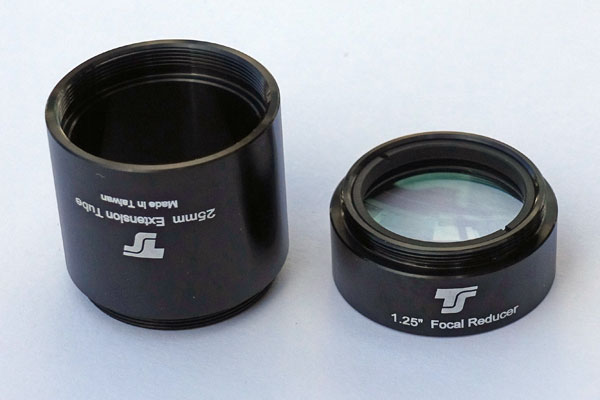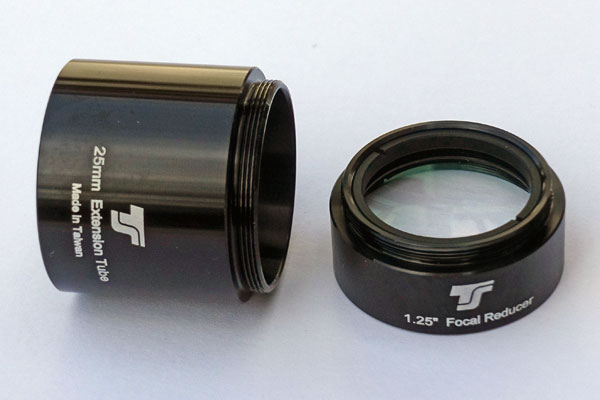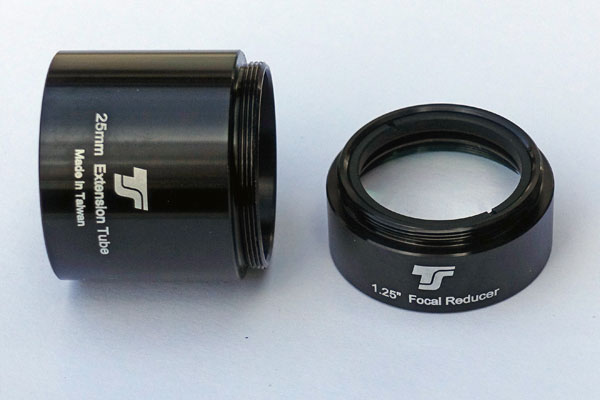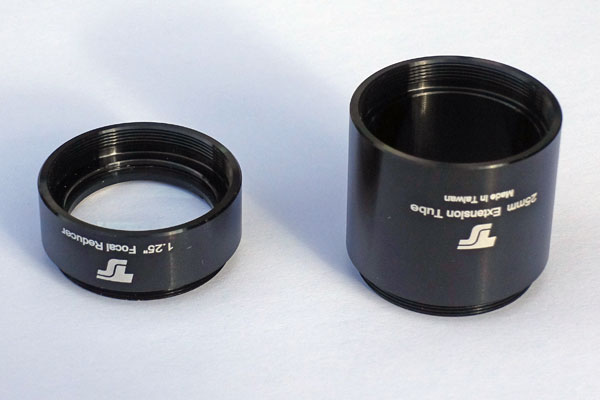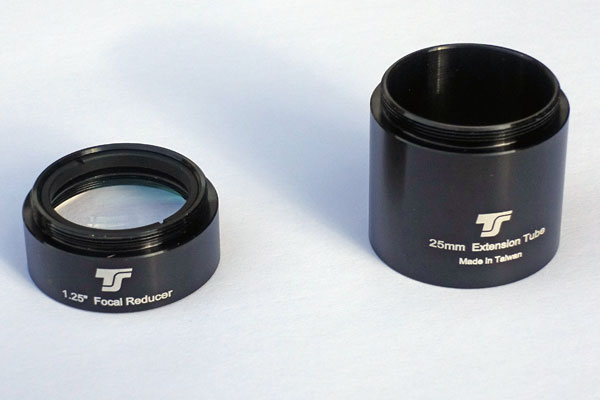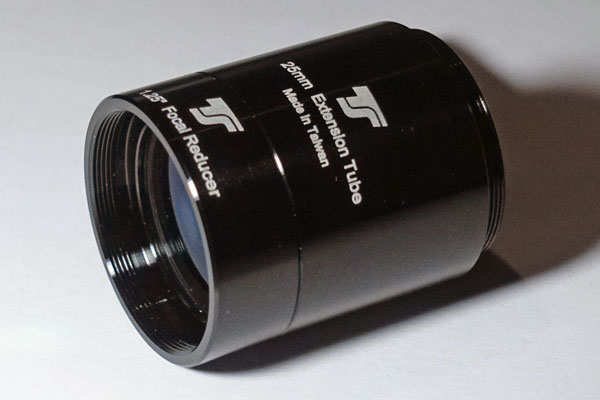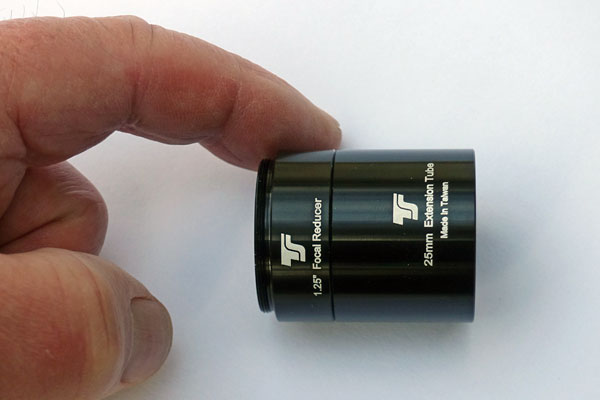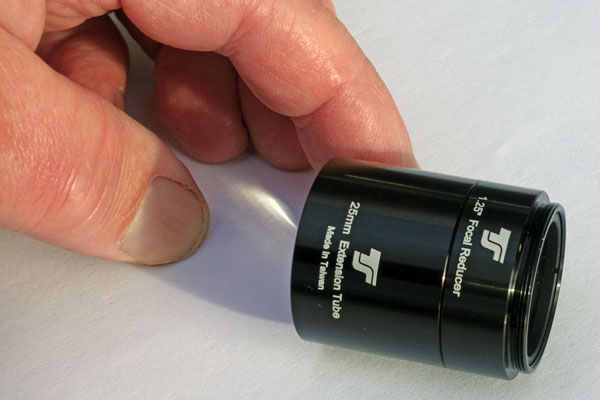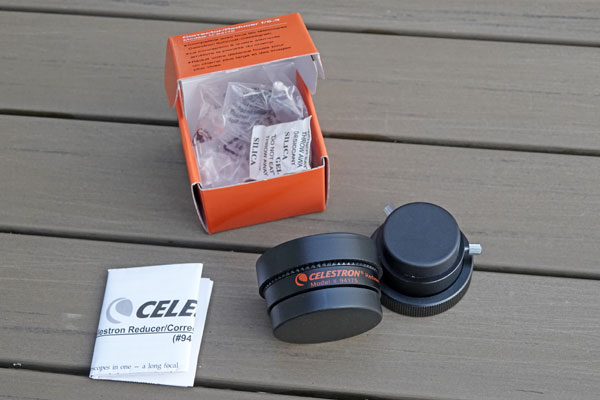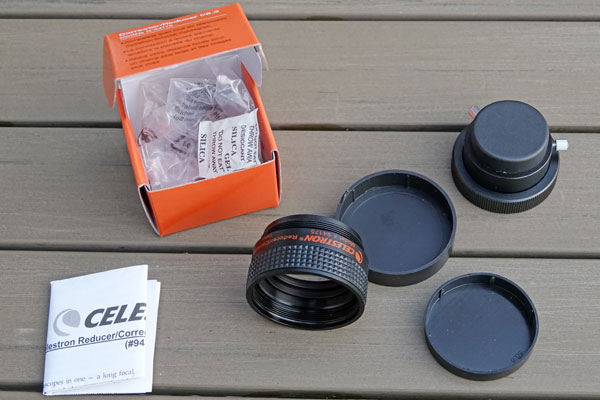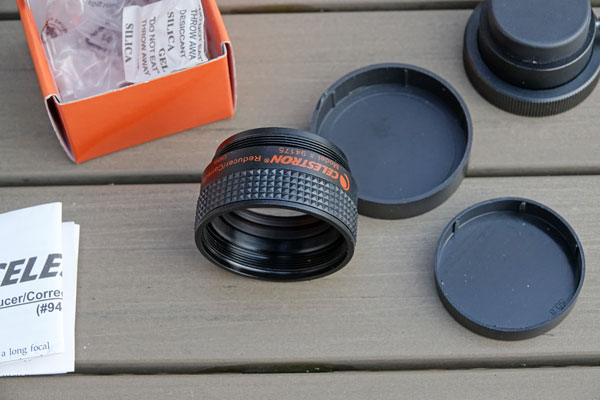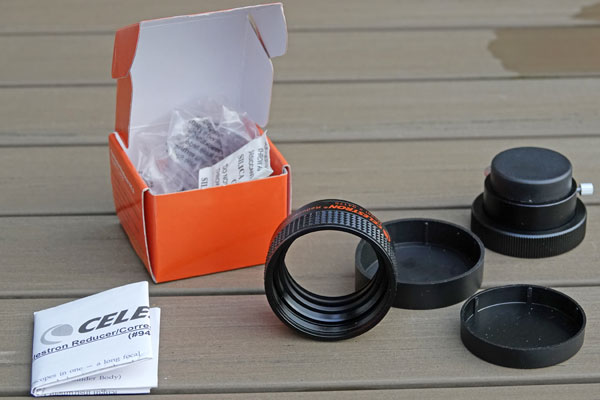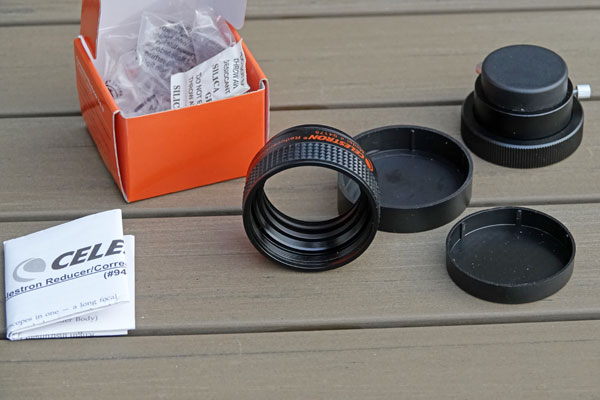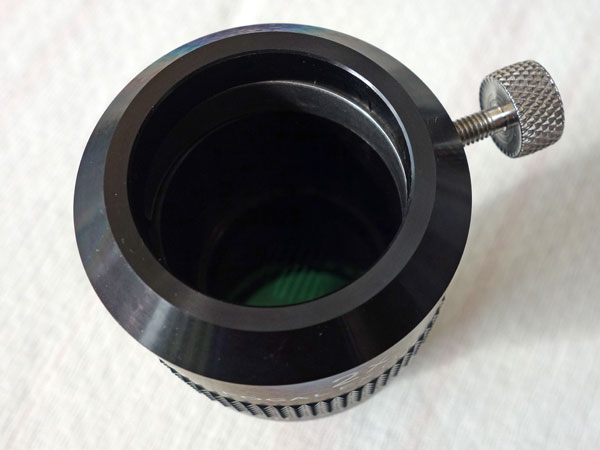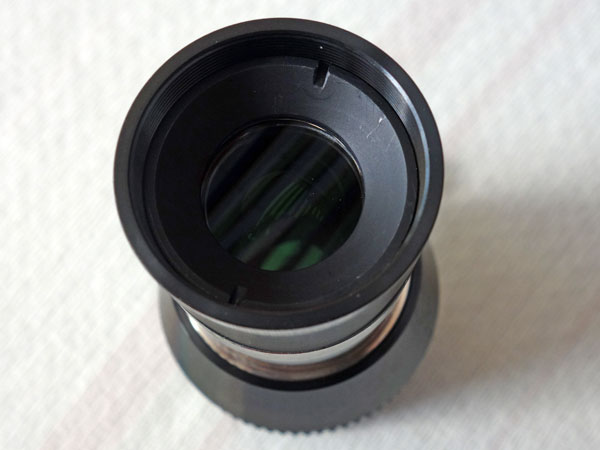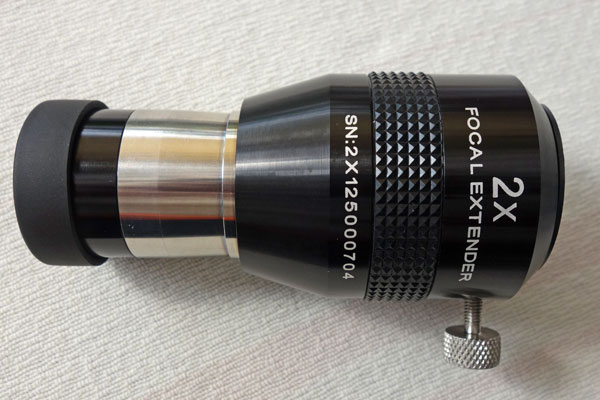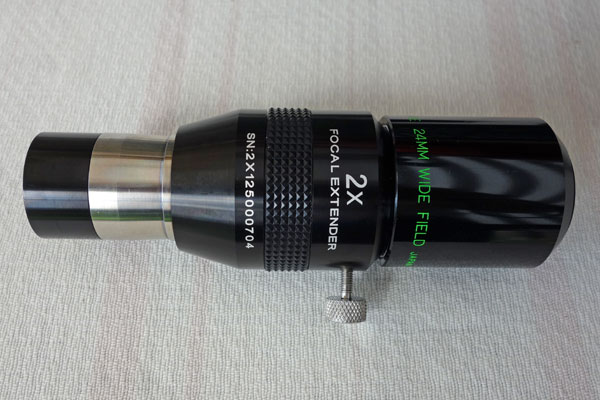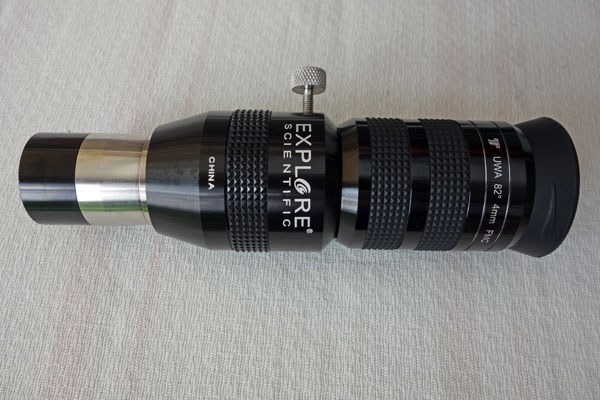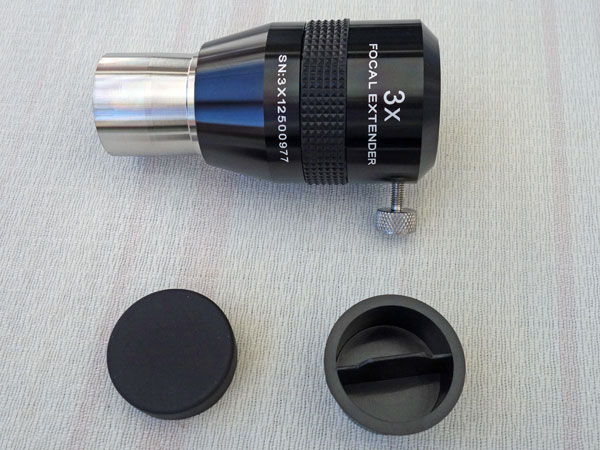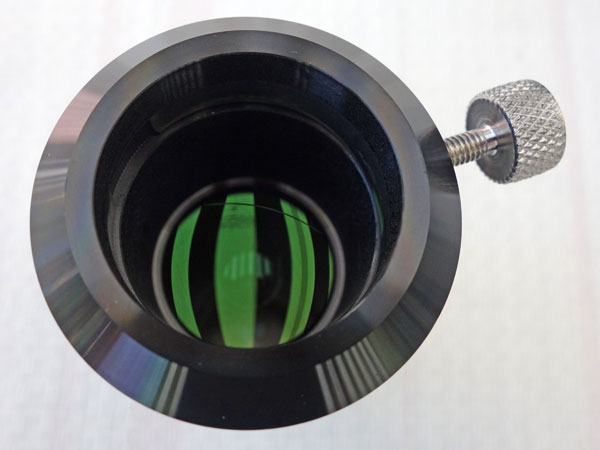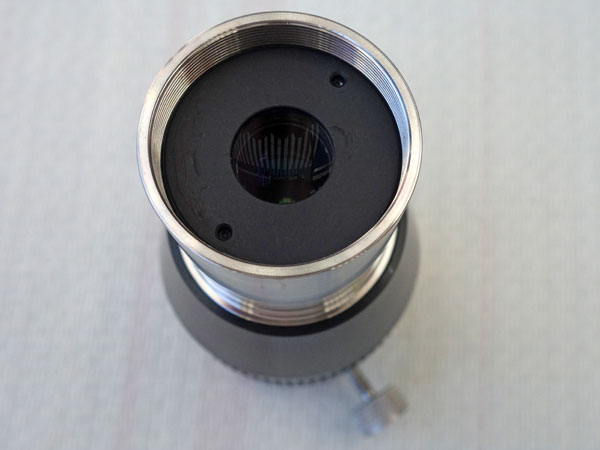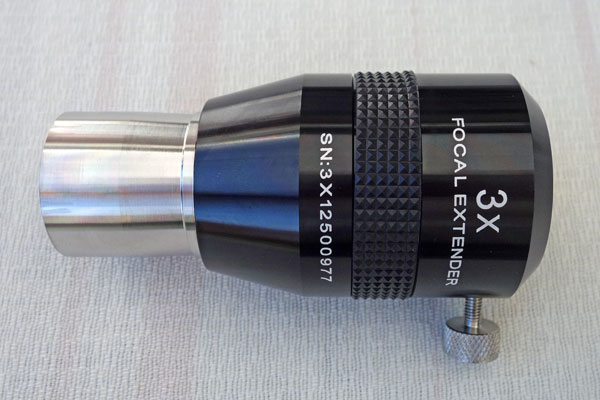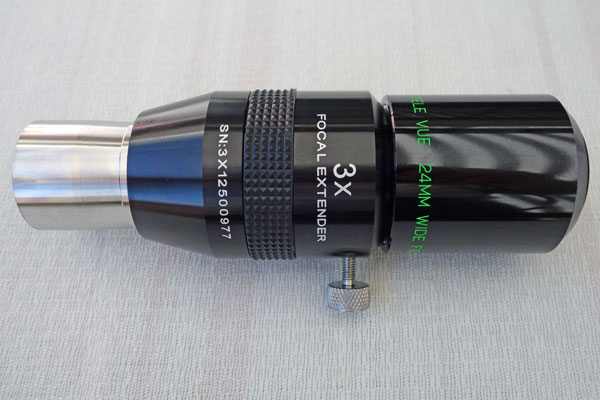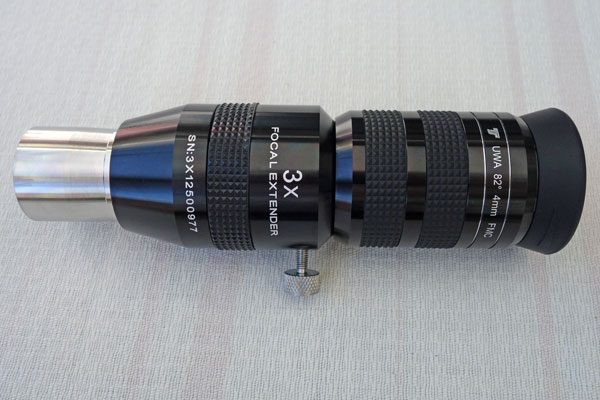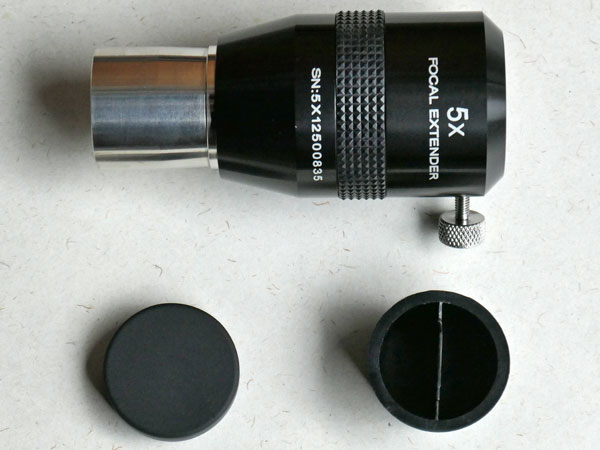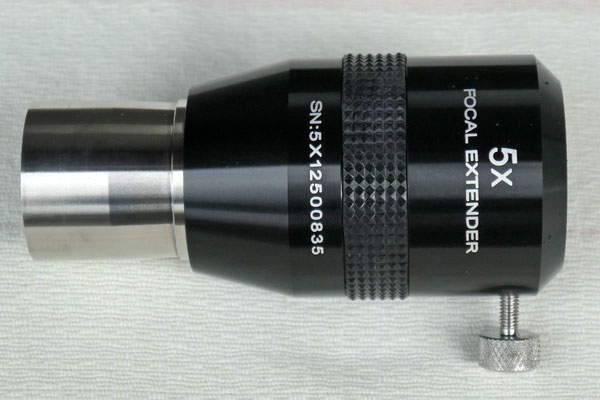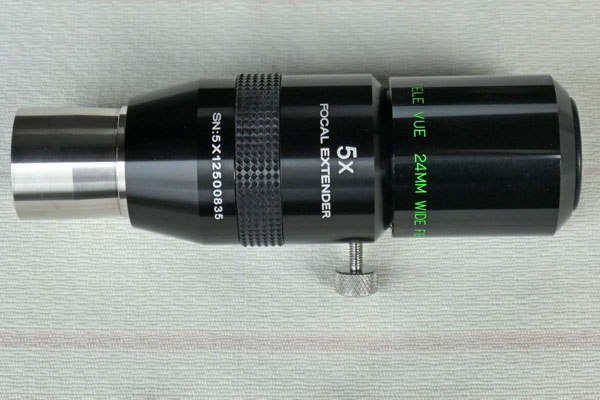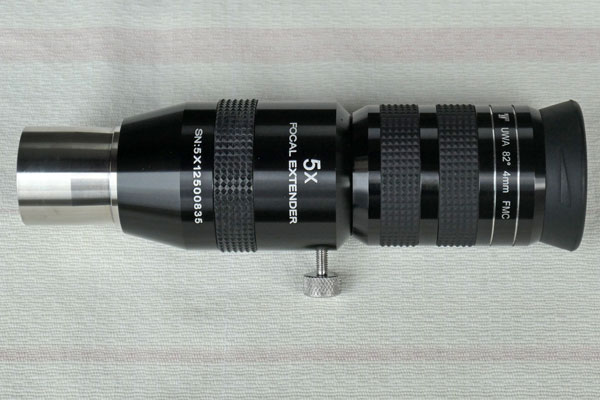Telescope Accessories - Part 1
Introduction | Finders | Amici Prisms and Star Diagonals | Dew Caps | Filters | Focal Reducers/Extenders | Focusing Aids
On this and a further page, I present an overview of my telescope accessories. Since there are now so many accessories, I need two pages for this...
See also: Telescope Accessories - Part 2
Introduction
As with all hobbies, you are not done with astronomy when you buy a telescope with perhaps two kit eyepieces. Unfortunately, this is only the beginning of a series of further investments. These do not only apply to larger and larger telescopes, but also to better eyepieces, which can be even more expensive than beginners' telescopes, as well as a wide range of accessories that improve the observation experience or make it possible at all.
Note: One might list the Atik Infinity Colour camera and the ZWO ASI224 camera as an accessory here as well, but I present it in a section of its own. Here is the information page for the Atik Infinity, and here the one for the ZWO ASI 224 (sold) and the ZWO ASI 294.
In the following I present the first part of the most important accessories (except eyepieces), which I acquired over time. This includes devices that...
- make it easier to find objects in the sky
(Finders)
- Red-dot finder
- Telrad finder (no longer in my possession)
- Rigel finder
- Angle finder
- flip the image so that it appears correctly or redirect the image for 90° so that you can look more easily through your telescope (refractor, MAK, ...), particularly for sky objects that are close to the zenith (Amici Prisms and Star Diagonals)
- Amici prism
- diagonal mirror (zenith mirror, star diagonal)
- allow to protect the telescope from dew (Dew Caps)
- protect your eyes (against damages, glare) and
improve the recognition of DSO (Filters)
- Solar filter (partly no longer in my possession)
- Variable polarizing filter
- UHC filter
- UV/IR cut filter
- shorten or extend the focal length of your telescope so that you can use your eyepieces more flexibly (Focal Reducers/Extenders):
- allow to focus a telescope more easily (Focusing
Aids)
- Bahtinov Mask (no longer in my possession)
- "Easy-sharp" Focusing Mask (no longer in my possession)
- Bahtinov Mask for PS 72/732
- Bahtinov Mask for eVscope (2)
Finders
Red-Dot Finder
|
Typical simple red-dot finder |
Ditto mounted on a telescope |
The red dot that is projected onto the sky |
Red-dot finders do not magnify and project a red dot (brightness adjustable) on the sky or on the object to be accessed.
Telrad Finder
|
Base from above and already mounted on the telescope tube |
Finder (without base) from the side. You can see the little feet for mounting the finder to the base as well as the main switch (left). |
Finder (without base) seen more from above |
|
Rear view of the finder; you can see the three collimation screws at the back and the main switch on the side (also regulates brightness of the LED/rings)
|
Telrad finder with LED switched on; regrettably, the rings on the mirror are blurred |
Telrad finder opened; battery holder on the right (2 AA cells) |
I purchased the Telrad finder for my GSD 680 telescope, because I prefer a red dot finder to a (magnifying) viewfinder. The Telrad finder projects three rings (corresponding to a visual angle of 0.5°, 2°, and 4°) on a mirror, which serve to target celestial objects. However, I have not yet resolved the assembly of the viewfinder at the GSO 680 telescope satisfyingly.
In February 2017, I bought a 5 cm riser base and a dew cap with 90° mirror for the Telrad finder:
|
Riser base (5 cm) |
Telrad with riser base and dew cap+ |
Mirror in "use" position... |
Note: In April 2017, I sold the Telrad finder including its accessories, because the Telrad finder was too large for my Sky-Watcher 6" Explorer 150PDS tube and I had given my 8" Dobsonian telescope to a dealer for selling it. I am therefore regrettably unable to report any further experiences with the Telrad finder on this site.
Links
- For details and first experiences see page Telrad Finder.
- Telrad Sucher (Wikipedia): de.wikipedia.org/wiki/Telrad-Sucher (in German)
- Telrad Finder: www.teleskop-express.de/shop/product_info.php/info/p308_Telrad-Sucher---die-Alternative-zum-optischen-Sucher---mit-Halte.html (in German) - www.teleskop-express.de/shop/product_info.php/language/en/info/p308_Telrad-Sucher---die-Alternative-zum-optischen-Sucher---mit-Halte.html (in English)
Rigel Finder
|
Rigel Quick Finder with second base plate |
View through the Rigel Finder |
Rigel Finder rear view |
I bought the Rigel Finder (or Quick Finder) for my PS 72/432 refractor, because you cannot mount a normal finder on it, since, like many refractors, the PS 72/432 does not have a finder shoe. The Rigel Finder projects two rings (corresponding to a viewing angle of 0.5° and 2°) onto a mirror, which are used to target sky objects (the Telrad finder projects three rings).
Links
- For details and first experiences see page Rigel Finder.
- Rigel Quick Finder: www.astroshop.eu/red-dot-projection-viewfinders/rigel-systems-quick-finder/p,50230 - www.teleskop-spezialisten.de/shop/Telescope-accessories/Viewfinder-and-accessories/Rigel-Red-Dot-Finder-with-two-bases-including-lighting::2743.html?language=en - www.teleskop-express.de/shop/product_info.php/language/en/info/p307_Rigel---Peilsucher-mit-zwei-Basen---inklusive-Beleuchtung.html
Angle Finder
I bought the Sky-Watcher 6 x 30 angle finder, because with a normal red dot finder for objects close to the zenith I have to crawl more or less "under" the finder (the telescope) in order to be able to see the object in the finder. Unfortunately, as far as I know, there are no LED red dot finders with a 90° view. So I had to resort to a magnifying finder. I chose a version that shows the sky upright and non-reversed, just like a normal LED red dot finder does.
|
Sky-Watcher angle finder |
Angle finder on the telescope |
Ditto, seen from the other side |
Links
- 6x30 finder scope with angled eyepiece and upright non-reversed image: www.astroshop.eu/optical-finders/skywatcher-6x30-finder-scope-with-angled-eyepiece-and-upright-non-reversed-image/p,16115
Amici Prisms and Star Diagonals
Amici Prism
An Amici prism serves for achieving a correct and upright image. I purchased the Baader Amici Prisma BA2956150 for 1.25" eyepiece mount and with 45° angle for terrestrial observations. The reason for buying this specific Amici prism was Baader's claim that this prism has a large opening (24 mm instead of 19 mm), larger than most others prisms. In addition, the glass surfaces multi-coated.
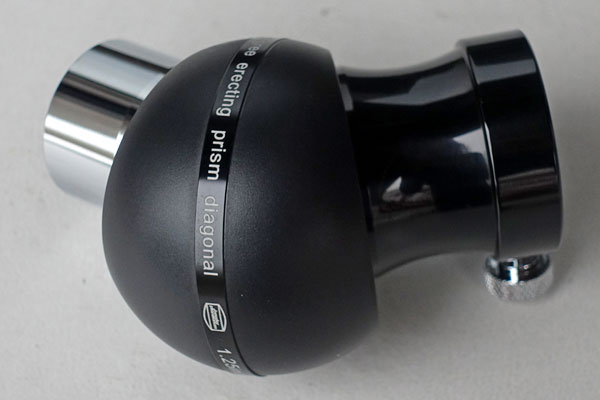 |
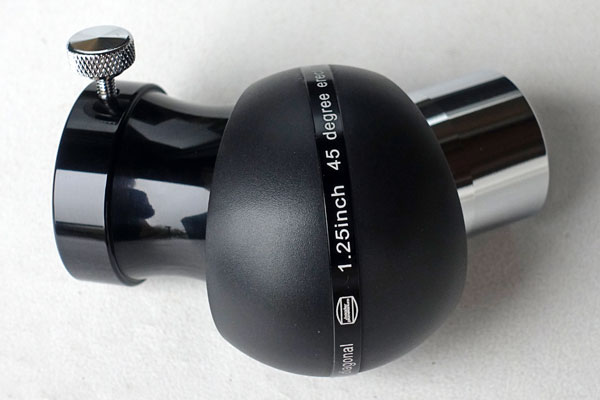 |
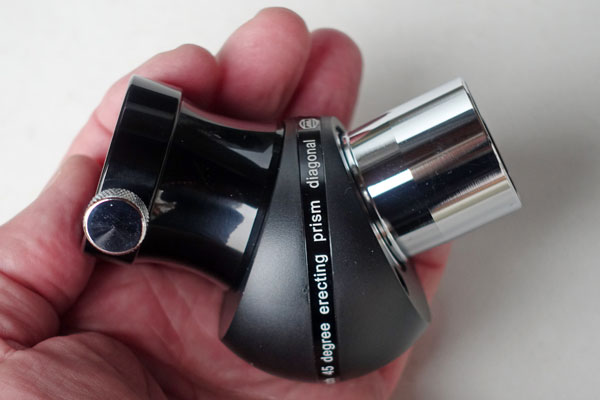 |
Baader 45° Amici Prism |
Ditto |
Ditto |
 |
 |
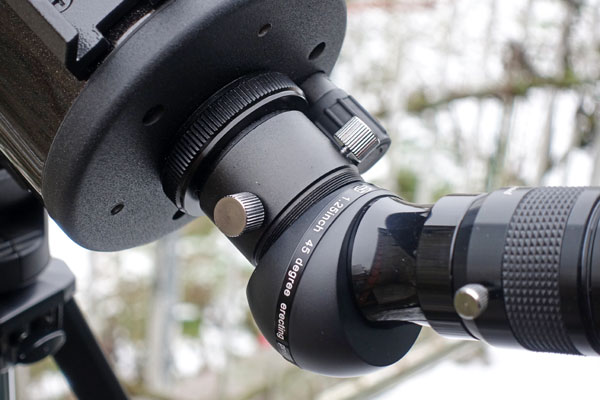 |
Baader 45° Amici Prism in use |
Ditto |
Ditto |
Addition: With my Celestron C5, I also got a simple Celestron Amici prism, which I do not use (and may give away):
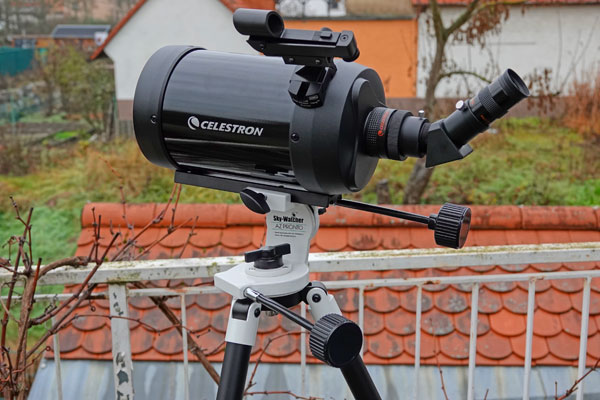 Celestron
25 mm Plössl- eyepiece and
Celestron Amici prism (with reducer/corrector)
Celestron
25 mm Plössl- eyepiece and
Celestron Amici prism (with reducer/corrector)
2'' to 1.25'' Amici Prism
I purchased the Omegon 45°, 2'' to 1.25'' Amici prism for terrestrial observations with the Omegon PS72/432 refractor, which allows to use 2" equipment. This Amici prism is recommended for the telescope.
 |
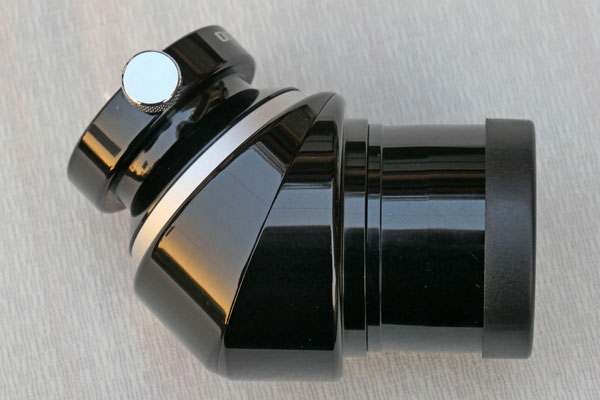 |
 |
Omegon 45°, 2'' to 1.25'' Amici prism |
Ditto |
Ditto |
 |
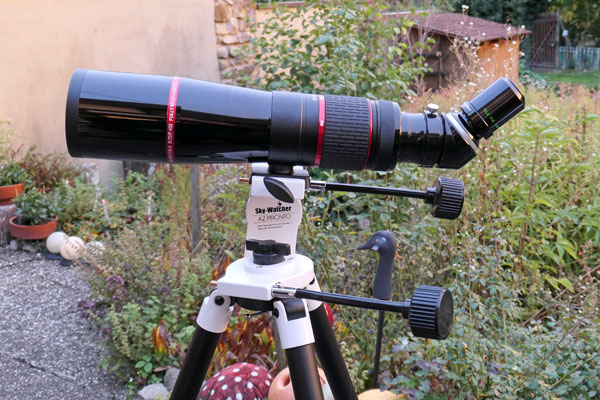 |
 |
Ditto |
Omegon 45°, 2'' to 1.25'' Amici prism in use |
Ditto, closer view |
Links
- Baader BA2956150 1.25" Amici Prism - 45° - 24mm free aperture: www.teleskop-spezialisten.de/shop//Prisms-Diagonals/::2577.html?language=en (note that, at the moment, there is neither a title nor a text in this ad...).
- Omegon 45°, 2'' to 1.25'' Amici prism: www.astroshop.eu/amici-prisms-45d/omegon-45d-2-to-1-25-amici-prism/p,33298
1.25" Star Diagonal
When you observe sky objects that are located close to the zenith using a refractor or a Maksutov-Cassegrain telescope, this can turn into acrobatics because you have to creep "under" the telescope to be able to look through the eyepiece. Diagonal mirrors (star diagonals, zenith mirrors) offer a remedy because they redirect the light by 90°. A diagonal mirror was included with my Sky-Watcher Maksutov Cassegrain telescopes, but this mirror is of lower quality (91% transmission). When I purchased a used Sky-Watcher Skymax 127 tube, I also got a better diagonal mirror (Lacerta, 99% transmission) because the previous owner had bought one additionally. However, right away I do not see much difference between the two mirrors...
Addition: With my Celestron C8, I also got a simple Celestron star diagonal, which I do not use (and may give away; see bottom row):
2" Star Diagonal
I purchased the Omegon star diagonal with 99% reflection, 2" with dielectric coating for my Omegon PS 72/432 refractor, because this telescope can utilize 2" accessories and because the 2" to 1.25" adapter from Sky-Watcher, which I wanted to use, did not fit securely in the eyepiece holder.
Omegon star diagonal with 99%
reflection, 2" (dielectric coating) with 2" to 1.25" adapter |
Ditto |
Omegon star diagonal in use
with 1.25" eyepiece |
Ditto, closer view |
Ditto with 2" eyepiece |
Ditto, closer view |
For the Celestron C8, I bought a 2" SC zenith mirror later, which I converted into a "real" 2" zenith mirror. I connect it via a Baader ClickLock clamp (with SC adapter) to the C8 tube.
TS-Optics SC 2" star diabonal
90° for
C8, dielectric coating with 2"-to-1,25" a dapter |
Transformed into
a "real" 2"zenith mirror |
2" zenith mirror (with 2"-to-1,25" adapter)
inserted into Baader ClickLock clamp |
Links
- There are no links for the Lacerta diagonal mirror available.
- Omegon star diagonal with 99% reflection, 2": www.astroshop.eu/diagonal-mirrors/omegon-star-diagonal-with-99%25-reflection-2-/p,13318
- TS-Optics SC 2" Star Diagonal: www.teleskop-express.de/shop/product_info.php/language/en/info/p84_TS-Optics-SC-Zenitspiegel---99--Reflexion---Ringklemmung---SC-Anschlus.html
Dew Caps
Astrozap Flexible Dew Cap for Celestron C8
Since Schmidt-Cassegrain telescopes are considered to be susceptible to due, I ordered a flexible dew cap together with my Cestron-C8 telescope. It has a recess for a prism rail; there are also models without and with two recesses.
Dew cap flat, outer side |
Dew cap flat, inner side |
Dew cap put on |
|
|
|
|
Ditto, other side with recess for the prism rail |
Ditto front view |
Ditto rear view |
Note: I sold my Celestron C8 in November 2022, together with the dew cap.
TS-Optics Dew Cap for Celestron C5
Since Schmidt-Cassegrain telescopes are considered to be susceptible to due, I also ordered a flexible dew cap (TS-Optics) for my Celestron C5 telescope. Regrettably, it does not have a recess for a prism rail.
|
Dew cap in its foil |
Dew cap does not lie flat, because of the packaging |
Dew cap flat, inner side |
|
Dew cap put on, front view; you can see the felt inside |
Dew cap put on; there is no recess for the prism rail |
Ditto |
Links
- Astrozap Flexible Dew Shield D=231 mm for Celestron NexStar 8SE and EHD (Teleskop-Express): www.teleskop-express.de/shop/product_info.php/language/en/info/p5728_Astrozap-flexible-Taukappe-fuer-Celestron-NexStar-8--SE---EHD---D-231-mm.html
- TS-Optics flexible Dew Shield for telescopes with a tube diameter from 140 to 180 mm: www.teleskop-express.de/shop/product_info.php/language/en/info/p8075_TS-Optics-flexible-Taukappe-fuer-Teleskope-mit-einem-Au-en--Tubusdurchmesser-von-140-bis-180-mm.html
Filters
Variable Polarizing Filter (Gray Filter)
|
Package |
The variable polarizing filter (a bit dirty) from above... |
...consists of two filters that can be turned to adjust the brightness |
|
Filter taken our of the package |
Filter at eyepiece |
Ditto, more oblique view |
The moon, as well as the planets, can be very bright - sometimes too bright - so that it is advisable to dampen the light. In addition, details of the moon or of planets can be overshadowed by areas that are too bright. Remedy is provided by gray filters of different densities or by variable polarization filters, which allow to adjust the brightness within certain limits (the filters are screwed into the eyepiece). I decided for the latter, even though damping the light is sometimes a bit "fiddly".
Link
- Variable polarizing filter: www.teleskop-express.de/shop/product_info.php/language/en/info/p321_Antares-Variabler-Polarisationsfilter---1-25----1--bis-40-.html
Solar Filter
The following solar filters utilize the Baader Planetarium Astro Solar film of density 5 (ND5), which is suitable for both visual observation and projection photography.
EMC Solar Filter SF 100, Order Number 600-105
In order to be able to observe the Mercury transit in May 2016, I acquired a euro EMC solar filter for my Sky-Watcher Heritage 100P Dobsonian telescope, namely the type SF 100 filter (order no. 600-105, size 5: for tubes with a diameter from 103 to 131 mm, aperture = 96 mm).
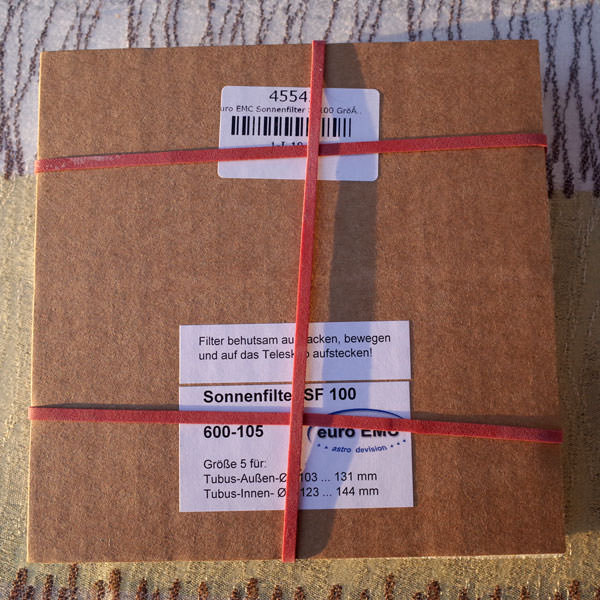 |
|
|
Packaging of the filter size 5 from above |
Ditto from below and with included Allen wrench |
|
Filter from below |
Filter from above |
Note: In March 2019, I gave away the EMC Sun Filter SF 100, order no. 600-105 (size 5), together with my Sky-Watcher 100P tube. I am therefore regrettably unable to report any further experiences with the filter size 5 on this site.
EMC Solar Filter SF 100, Order Number 600-106
In order to be able to also observe the sun, I acquired a euro EMC solar filter for my Sky-Watcher Skymax-127 OTA, namely the type SF 100 filter (order no. 600-106, size 6: for tubes with a diameter from 129 to 157 mm, aperture = 120 mm).
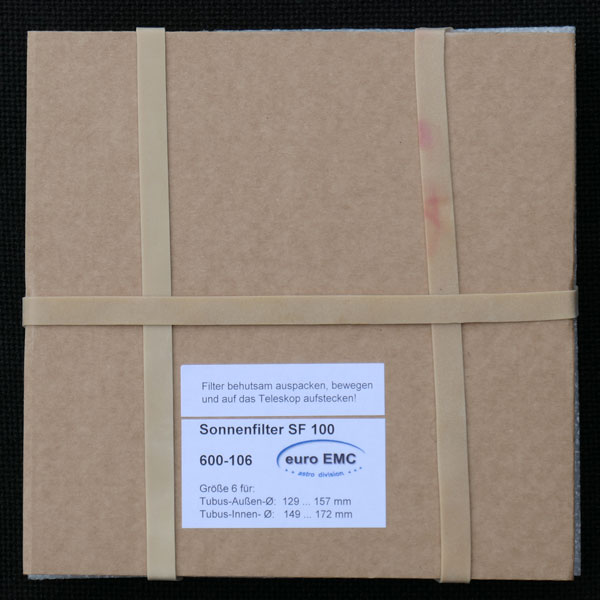 |
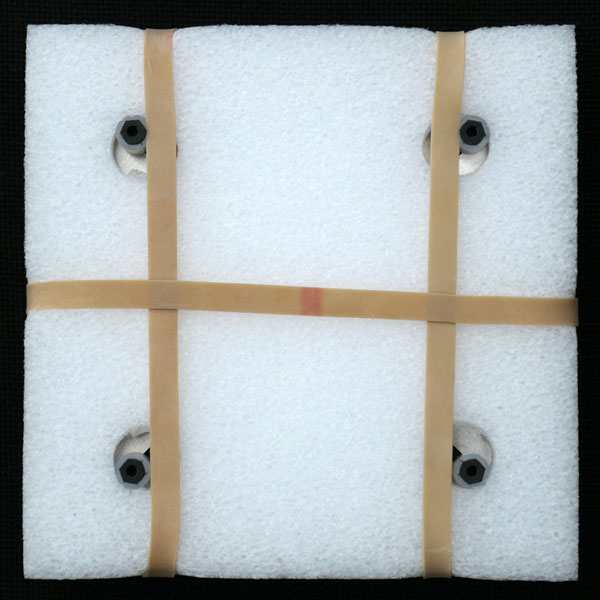 |
|
Packaging of the filter from above (size 6) |
Ditto from below |
|
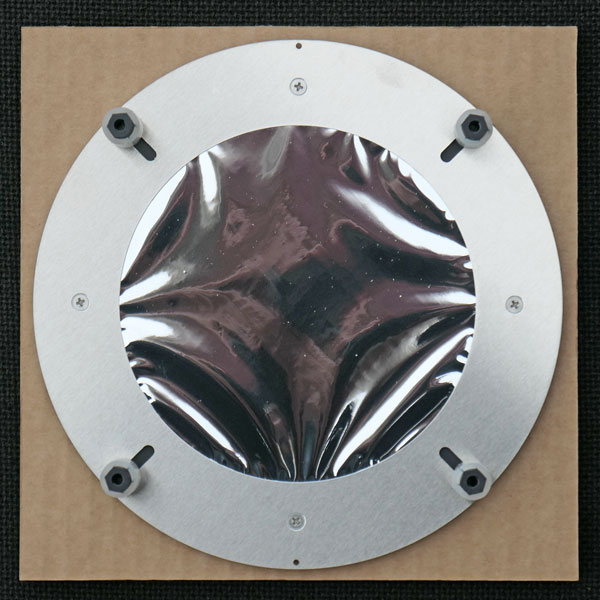 |
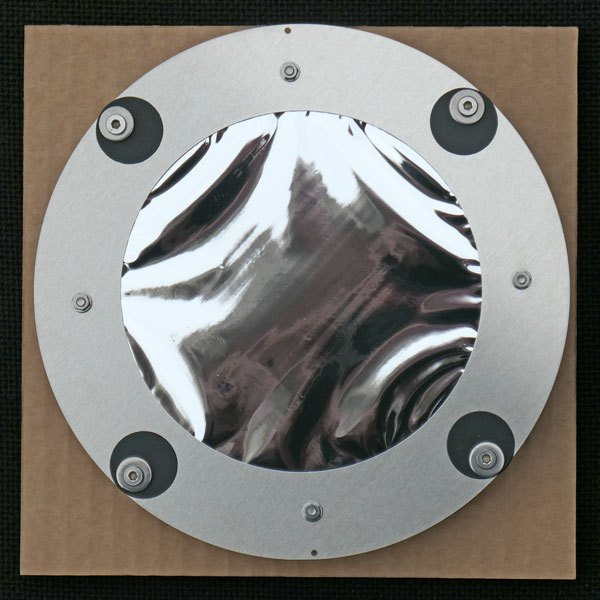 |
|
Filter from below |
Filter from above |
EMC Solar Filter SF 100, Order Number 600-107
In order to be able to also observe the sun, I acquired a euro EMC solar filter for my Sky-Watcher Explorer 150PSD Newton tube, namely the type SF 100 filter (order no. 600-107, size 7: for tubes with a diameter from 155 to 202 mm, aperture = 146 mm).
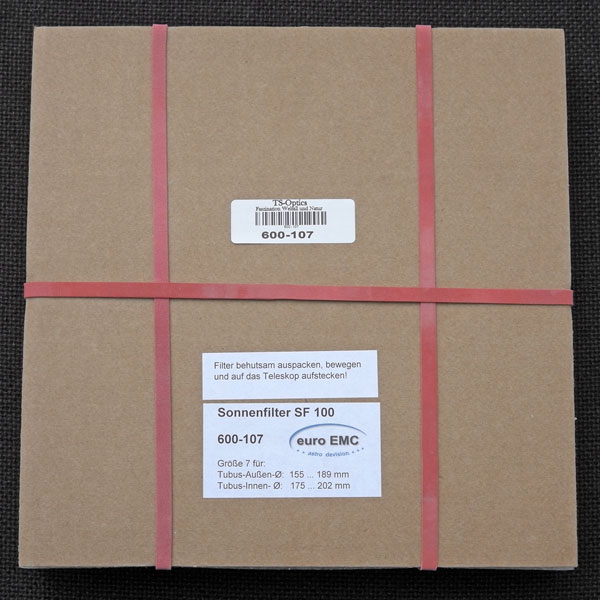 |
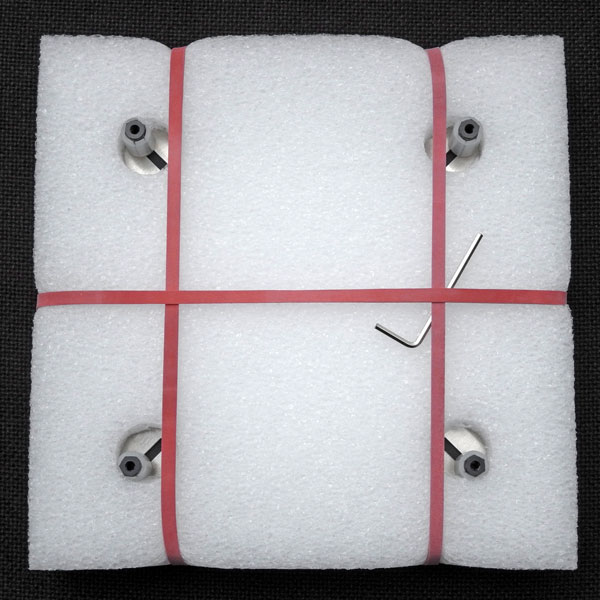 |
|
Packaging of the filter size 7 from above |
Ditto from below and with included Allen wrench |
|
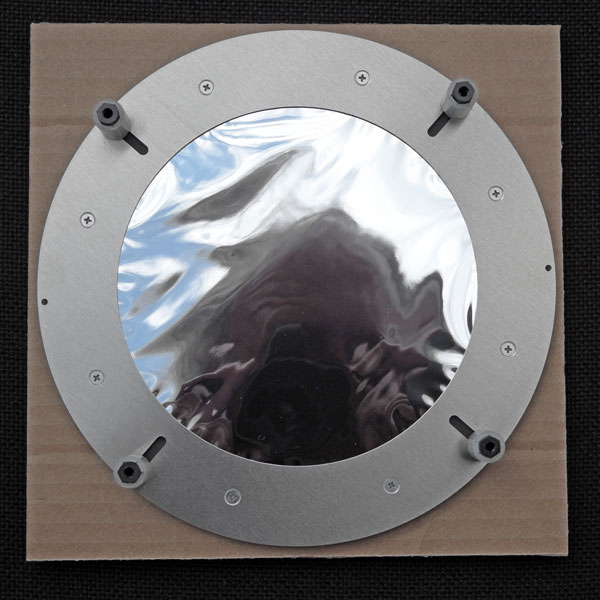 |
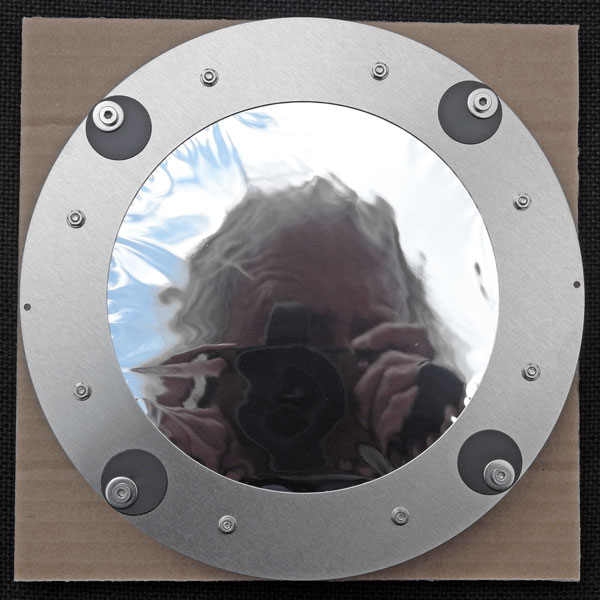 |
|
Filter from below |
Filter from above |
Note: In January 2019, I sold the EMC Sun Filter SF 100, order number 600-107 (size 7), together with my Sky-Watcher Explorer 150PDS Newton tube. I am therefore regrettably unable to report any further experiences with the filter size 7 on this site.
EMC Solar Filter SF 100, Order Number 600-109
Initially, I had purchased a solar filter from the same series for my GSO GSD 680 8" Dobsonian telescope (order no. 600-109, size 9: for tubes with a diameter from 219 to 283 mm, aperture = 207 mm).
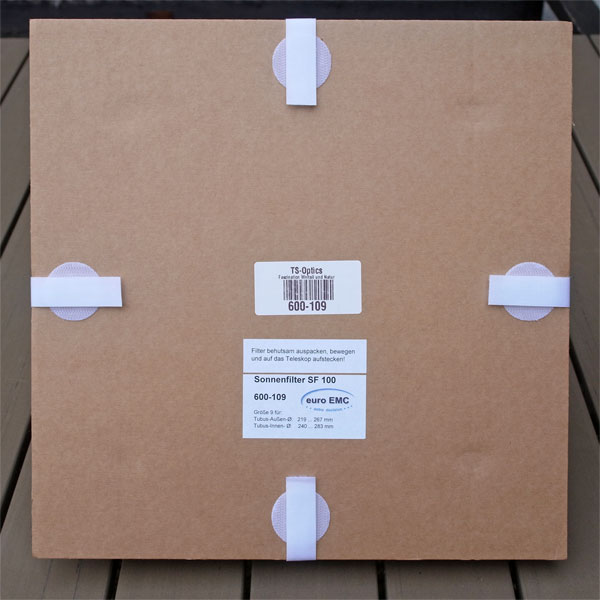 |
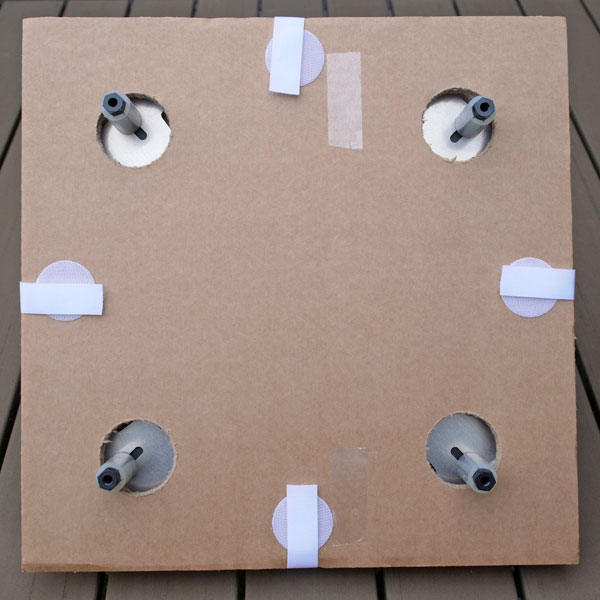 |
|
Packaging of the filter from above |
Ditto from below |
|
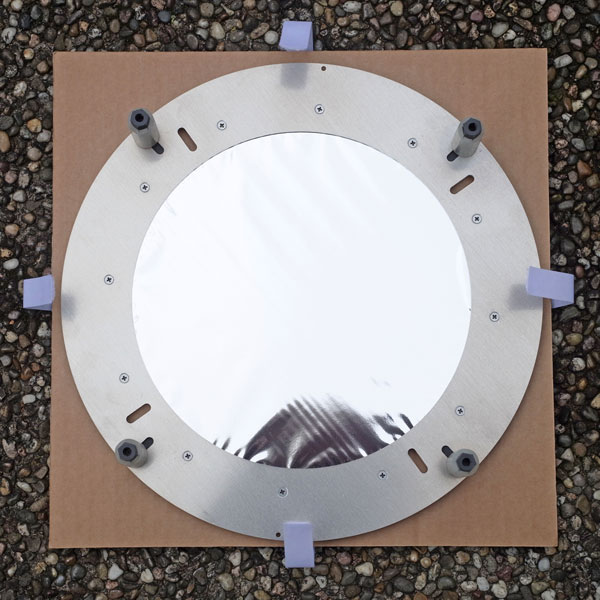 |
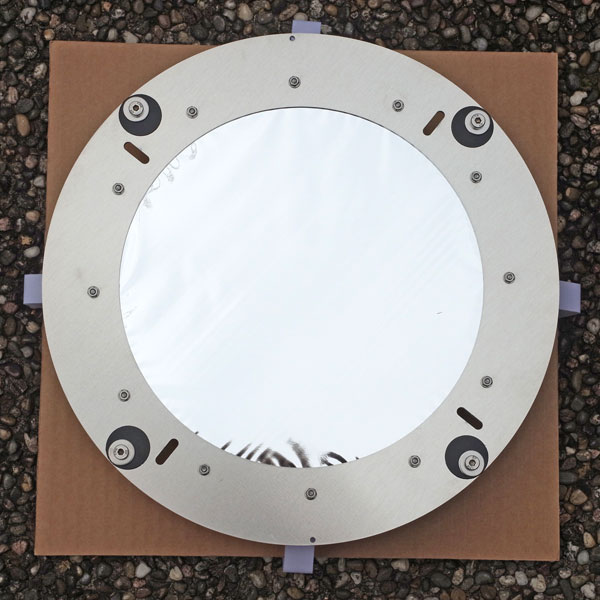 |
|
Filter from below - note the 4 additional slots (from size 9 on) |
Filter from above - note the 4 additional slots (from size 9 on) |
But I had to order also the smaller filter, because, due to a surgery, I was no longer able to carry the heavy 8" telescope. So I had to resort to my smallest telescope, the Heritage 100P, for the observation of the Mercury transit in May 2016.
Note: In April 2017, I sold the EMC Sun Filter SF 100, order number 600-109 (size 9), because I sold my GSO GSD 680 8" Dobsonian telescope (it was too heavy for me). I am therefore regrettably unable to report any further experiences with the filter size 9 on this site.
Links
- For details and first experiences see pages Sun Filter for Heritage 100P and 114P, Sun Filter for the GSD 680, and Mercury Transit 2016.
- Visual solar filter EMC SF100 600-105: www.teleskop-express.de/shop/product_info.php/language/en/info/p5511_Euro-EMC-visueller-Sonnenfilter---D--96-mm--fuer-103-144-mm-Teleskoptuben.html
- Visual solar filter EMC SF100 600-106: www.teleskop-express.de/shop/product_info.php/language/en/info/p7693_Euro-EMC-visueller-Sonnenfilter---D--120-mm--fuer-129-170-mm-Teleskoptuben.html
- Visual solar filter EMC SF100 600-107: www.teleskop-express.de/shop/product_info.php/language/en/info/p5516_Euro-EMC-visueller-Sonnenfilter---D--146-mm--fuer-155-202-mm-Teleskoptuben.html
- Visual solar filter EMC SF100 600-109: www.teleskop-express.de/shop/product_info.php/language/en/info/p7696_Euro-EMC-visueller-Sonnenfilter---D--207-mm--fuer-219-283-mm-Teleskoptuben.html
UHC Filter
|
Explore Scientific 2" UHC filter (box) |
Box opened, spec sheet |
UHC filter, closer view |
The Explore Scientific 2" UHC filter lets only the emission lines of hydrogen at 486 nm and 656 nm and of oxygen at 496 nm and 501 nm pass through. It is generally recommended for emission nebulae. Using this filter, you can see nebulae without any problems that are practically invisible with a telescope when the sky is slightly brightened, for example the Owl Nebula M 97, the Cirrus Nebula NGC 6992, or even the Dumbbell Nebula M 27.
Link
- Explore Scientific 2" UHC UHC filter: www.explorescientific.co.uk/en/Filters/EXPLORE-SCIENTIFIC-2-UHC-Nebula-Filterare.html
UV/IR Cut Filter
When I operated the Atik Infinity camera and later also the ZWO ASI224 camera at my PS 72/432 refractor in spring 2021, I noticed "bloated" star images. I learned that UV/IR cut filters are a solution to this problem. First I borrowed one such filter, and when I was able to confirm its effectiveness, I purchased a Baader UV/IR cut filter. In addition, my star friend gave me another such filter as an internal filter for the ASI224, which I acquired from him. So far, however, I have only used the Baader filter because it is easier to use (it can also be used with the Atik Infinity).
|
Baader 1,25" UV/IR cut filter and ASI224 filter in their boxes |
Boxes opened |
The two filters... |
|
M 51 (18 frames, 10 s, gain 300), ASILive, from FITS file and processed, with UV/IR cut filter |
M 51 (18 frames, 10 s, gain 300), ASILive, from FITS file and processed, without UV/IR cut filter |
UV/IR cut filter, closer view |
Link
- Baader UV/IR Cut / L-Filter 1¼" (Baader Planetarium): www.baader-planetarium.com/en/baader-uvir-cut--l-filter.html
Focal Reducers/Extenders
Focal Reducer
Focal reducers, as the name implies, shorten the focal length of a telescope. Using them actually doubles the number of eyepieces (or triples them for two reducers), but usually and in contrast to Barlow lenses and focal externders, this is not the reason why they are being used. In December 2017, I purchased a simple 2 x focal reducer from TS Optics (1.25"), plus a 1.25" extension sleeve (2.5 cm long) that transforms it into a 3 x reducer (the exact values depend on the distances).
Focal reducers are primarily used in astrophotography to increase the field of view. According to their factor, they also increase the the aperture ratio of the telescope. But as I found out (and read somewhere...) they also decrease the apparent field of view...
Note: In September 2020, I sold the TS focal reducer 2 x together with the extension tube. I am therefore regrettably unable to report any further experiences with them.
Links
- TS Optics TSRED051 Focal reducer 0.5x - 1.25 inch filter thread: www.teleskop-express.de/shop/product_info.php/language/en/info/p676_TS-Optics-Optics-TSRED051-Brennweitenreduzierer-0-5x-mit-1-25-Zoll-Filtergewinde.html
- Extension tube with reciprocal filter thread (25 mm): www.teleskop-express.de/shop/product_info.php/info/p364_Extension-Tube---1-25--Filter-thread---25mm-length.html
Focal Reducer/Corrector
Both the Celestron C8 and the C5 have a focal ratio of f/10, which makes them less usable for EAA or astrophotography. In addition, their focal lengths are comparatively long. Celestron therefore offers an f/6.3 reducer/corrector, which reduces the focal length of both tubes, increases the focal ratio to f/6.3 and also is said to flatten the field of view. I bought such a reducer/corrector, because it makes both tubes much more flexible. There seem to be several versions on the market (in addition, Meade offers a similar device), and I bought a version "made in China".
|
Reducer/corrector in the box next to the 1,25" Visual Back |
Box opened, reducer/corrector taken out |
|
Links
- Celestron Reducer / Corrector f/6.3 for Schmidt-Cassegrains Telescopes (SCT): www.teleskop-express.de/shop/product_info.php/language/en/info/p2644_Celestron-Reducer-Korrektor-f-6-3-fuer-Schmidt-Cassegrain-SC-Teleskope.html
Focal Extender (Tele Extender)
Extenders such as Barlow lenses or telecentric extenders (Focal Extender or Tele Extender) prolong the focal length of telescopes, so that you can virtually double or triple the number of your eyepieces if you use one or two of them. In May 2017, I first bought a 2 x focal extender from Explore Scientific and shortly afterwards a 3 x version of it. In December 2018 I finally bought a 5 x focal extender from Explore Scientific, because I had seen that such extenders are often used in combination with refractors.
Like Barlow lenses, focal extenders move the focus point outward. This can be relevant in the case that a camera does not come into focus, which is often the case with telescope tubes that are primarily designed for visual observation.
Note: I sold my Explore Scientific Focal extenders 2x, 3x, and 5x in November/December 2022. I am therefore regrettably unable to report any further experiences with them.
Links
- EXPLORE SCIENTIFIC 1.25" 2X FOCAL EXTENDER (USA): explorescientificusa.com/collections/focal-extenders/products/1-25-focal-extender
- EXPLORE SCIENTIFIC 1.25" 3X FOCAL EXTENDER (USA): explorescientificusa.com/collections/focal-extenders/products/1-25-3x-focal-extender
- EXPLORE SCIENTIFIC 1.25" 5X FOCAL EXTENDER (USA): explorescientificusa.com/collections/focal-extenders/products/1-25-5x-focal-extender
- EXPLORE SCIENTIFIC Tele extender 2x 31.7mm/1.25": www.explorescientific.co.uk/en/Eyepieces/Fokal-Extender-2x-31-7mm-1-25.html?force_sid=1cacd33b198f75fb42704f07a6d50ace&_ga=2.22254206.457994657.1495375286-312407702.1458939234
- EXPLORE SCIENTIFIC Tele extender 3x 31.7mm/1.25": www.explorescientific.co.uk/en/Eyepieces/Fokal-Extender-3x-31-7mm-1-25.html?force_sid=763a637d2d6b88518ceb13ab285146d1&_ga=2.13627447.161251290.1495623817-312407702.1458939234
- EXPLORE SCIENTIFIC Tele extender 5x 31.7mm/1.25": www.explorescientific.co.uk/en/Eyepieces/Fokal-Extender-5x-31-7mm-1-25.html?force_sid=763a637d2d6b88518ceb13ab285146d1&_ga=2.13627447.161251290.1495623817-312407702.1458939234
Focusing Aids
Bahtinov Mask and "easy-sharp" Focusing Mask
Both with my Atik Infinity camera and when photographing with the projection method, I have problems with focusing the telescope reliably. I therefore bought two focusing aids on the AME2018 astronomy fair in Villingen-Schwennigen, Germany: a Bahtinov mask from Lacerta and an "Easy-sharp" focusing mask from noctutec. I cannot report my experiences, because I sold them together with my 6" tube before I ever used them in practice.
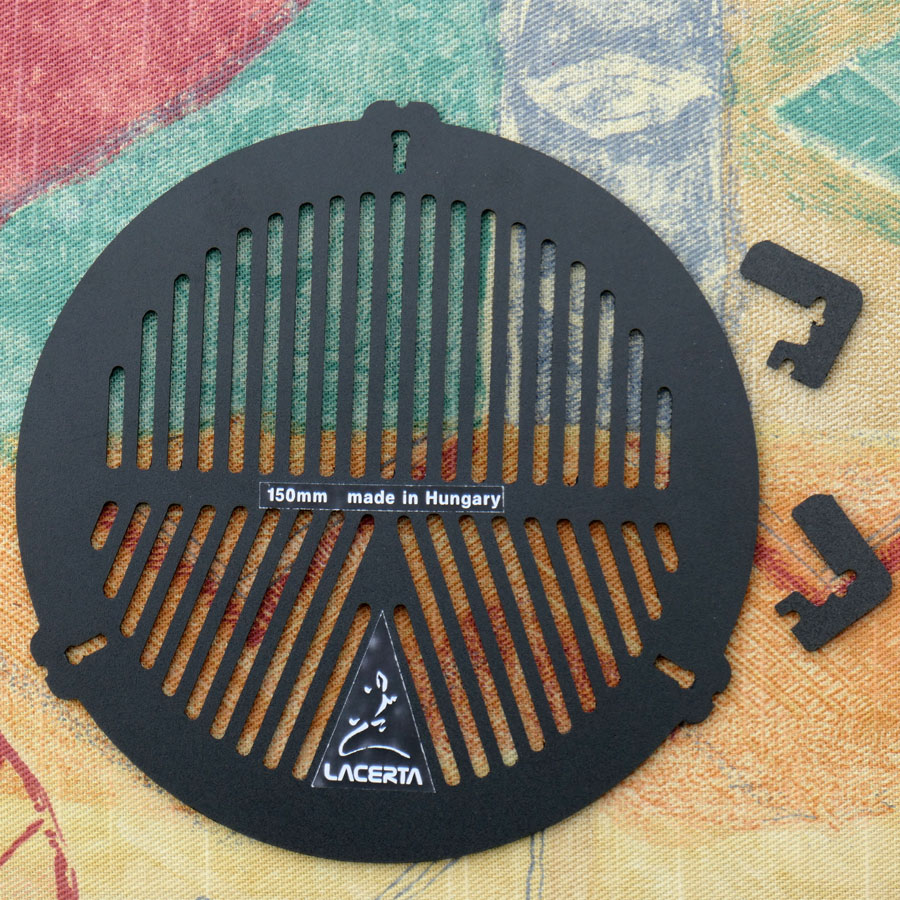 |
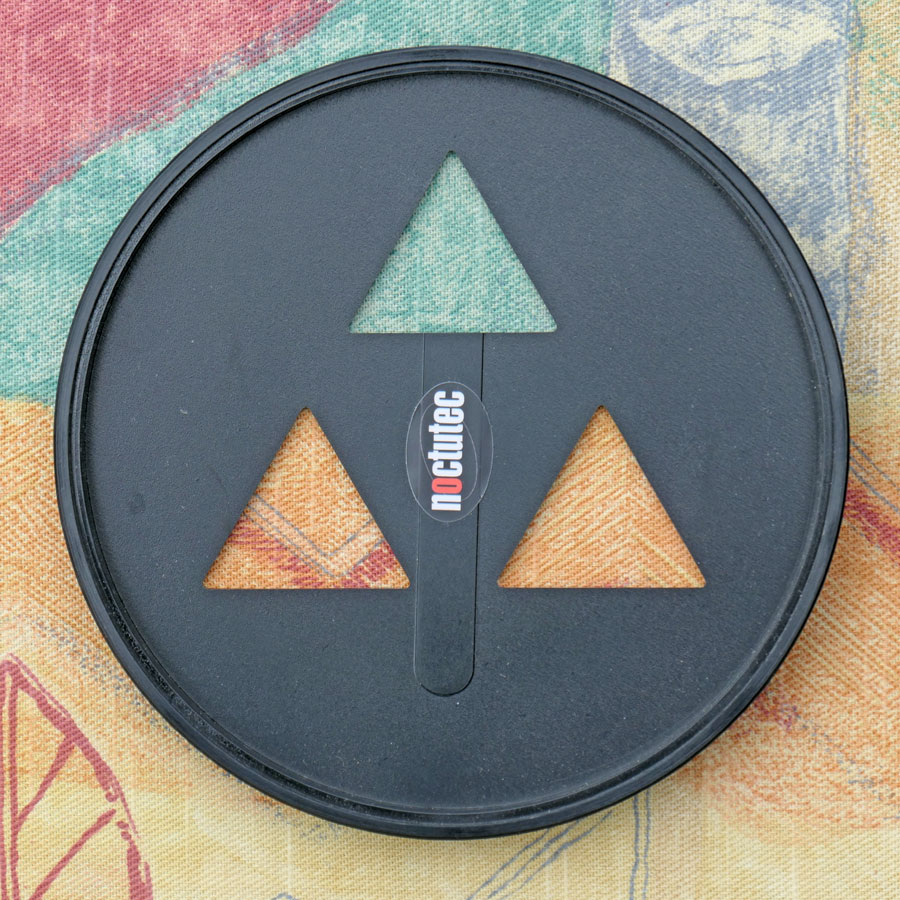 |
Bahtinov mask (Lacerta, for 150 mm aperture), delivered with 3 clamps |
"easy-sharp" mask (noctutec, for 150 mm aperture) |
Note: In January 2020, I sold both focusing masks together with my Explorer 150PDS tube. I am therefore regrettably unable to report any further experiences with the masks on this site.
Bahtinov Mask for PS 72/732
In April 2021, I first borrowed an ASI224MC camera from a starfriend and later bought it from him, which I also wanted to use at my PS 72/432 refractor. However, first tests showed that focusing a camera is even more tedious than focusing visually. I therefore was looking for an approach that provides a clear criterion for optimal focus. This is offered by the two masks described above, but since only the Bahtinov mask was available in the required size, I ordered and received an Omegon Bahtinov mask (mid-May 2021). In addition, I have had quite a good experiences with the Bahtinov mask for the eVscope.
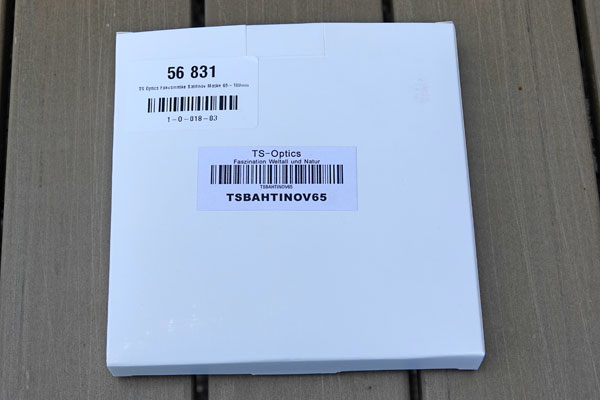 |
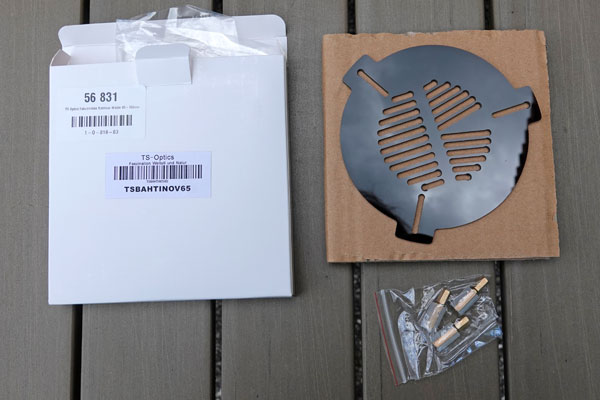 |
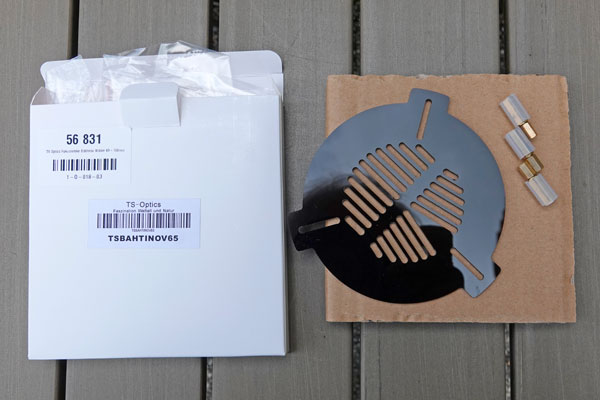 |
||
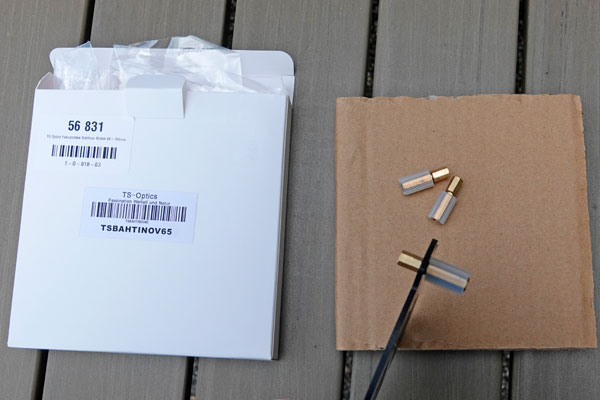 |
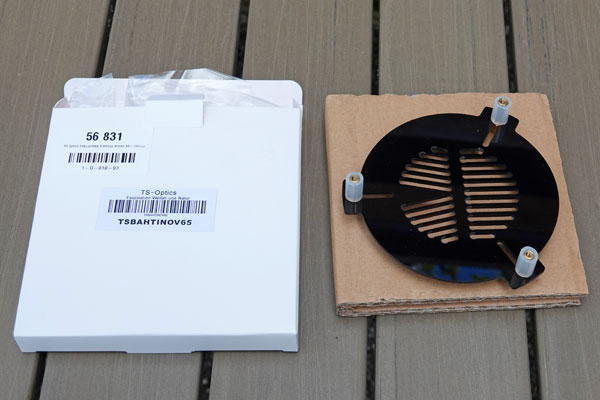 |
 |
Bahtinov Mask for eVscope (2)
At the end of January 2020, I got my eVscope and, together with it, a Bahtinov mask. All in all, I find the mask quite useful. For more information, see the eVscope section or page Focusing Aids.
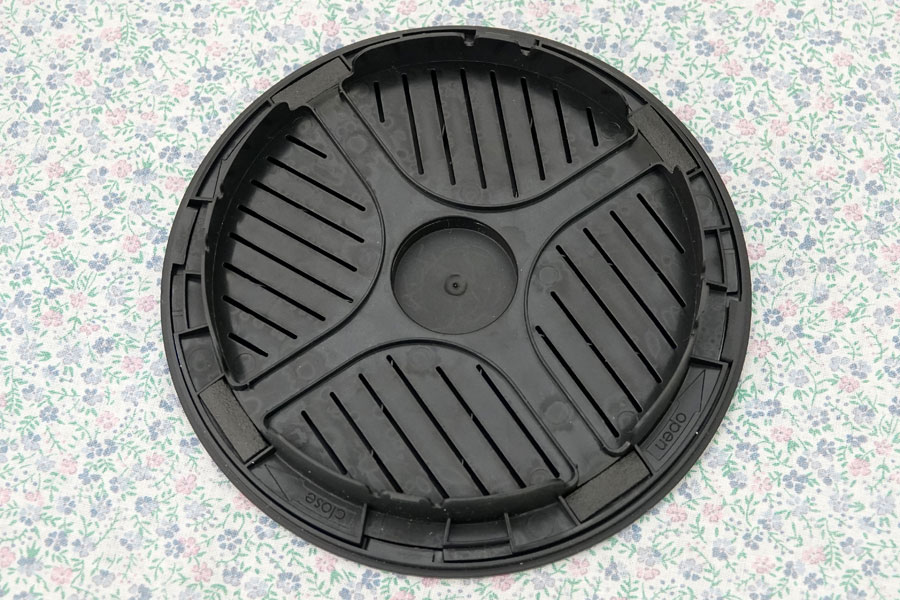 |
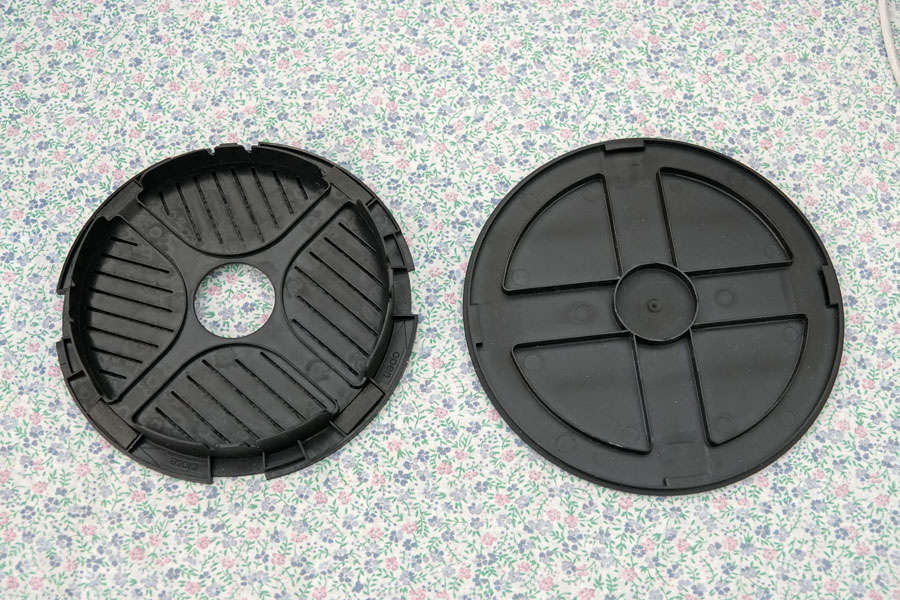 |
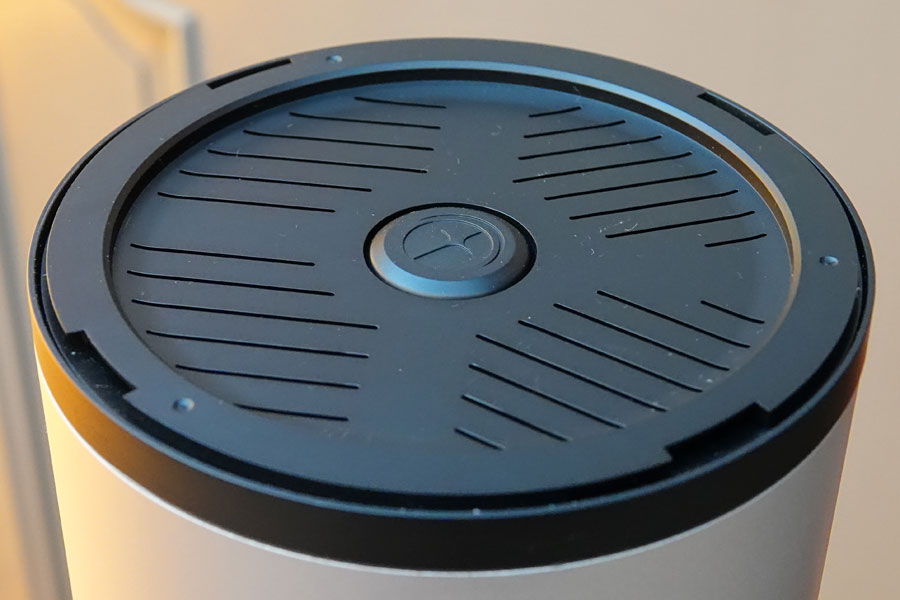 |
||
Bahtinov mask inserted in the telescope lid |
Bahtinov mask next to the telescope lid |
Bahtinov mask put on the eVscope tube |
Update: While I sold my eVscope (in spring 2022), I bougth an eVscope 2 with the same type of focusing aid. Meanwhile, I also sold my eVscope 2 (December 2023).
Links
- For detailos and first experiences, see also page Focusing Aids.
- Bahtinov mask (Astrogarten): astrogarten-shop.de/en/accessories/focusers/lacerta-bahtinov-mask-150mm.html?language=en
- "easy-sharp" mask (noctutec): www.noctutec.com/astronomie-zubehoer (in German)
- TS Optics Bahtinov mask, 65-100mm (astroshop.de): www.astroshop.eu/focusing-masks/ts-optics-bahtinov-mask-65-100mm/p,56831
- TS-Optics Bahtinov Mask for Astrophotography - D= 65mm to 100mm: www.teleskop-express.de/shop/product_info.php/language/en/info/p6373_TS-Optics-Bahtinov-Maske-fuer-Astrofotografie---D--65mm-bis-100mm.html
- eVscope (2): Focus. How to use the Bahtinov mask ? (help.unistellar.com/hc/en-us/articles/360010625099-Focus-How-to-use-the-Bahtinov-mask-)
| 19.01.2025 |
